You are using an outdated browser. Upgrade your browser today or install Google Chrome Frame to better experience this site.
- Section 10 - Nepal
- Section 10 - Vietnam

CDC Yellow Book 2024
Author(s): James Heffelfinger, Joshua Mott, Sopon Iamsirithaworn
Destination Overview
Infectious disease risks.
- Environmental Hazards & Risks
Safety & Security
Availability & quality of medical care.
Thailand, a geographically diverse country a little smaller than the state of Texas (see Map 10-14 ), is a popular destination for tourists, offering beaches, a wide range of cultures and cuisine, eco-adventure opportunities, nightlife, and shopping. Thailand is also a regional business hub. In 2019, ≈40 million visitors spent >1 night in Thailand—the number of visitors to Thailand increased annually during each of the 5 years before the onset of the coronavirus disease 2019 (COVID-19) pandemic. During 2020, Thailand had <7 million visitors, an 80% reduction compared with 2019, mainly due to COVID-19 travel restrictions.
Of a total population of 70 million people, >10 million live in the capital city of Bangkok, a major commercial center. Tourists to Bangkok visit historic and cultural sites including Buddhist temples, the Grand Palace, and the Emerald Buddha. The main arteries of Bangkok are the Chao Phraya River and its canals, which provide access to tourist sites, the floating market, and restaurants. Bangkok includes many culinary options, from sidewalk noodle stands to 4- and 5-star restaurants representing a variety of global cuisines. Although Thai is a tonal language that can be difficult for Americans to learn, English is commonly spoken at most popular destinations. Maps, road signs, and tourist guides frequently provide information in both English and Thai.
Many visitors to Thailand also visit Chiang Mai in the north. The old city is surrounded by a moat and defensive wall; beyond the wall are >300 temples, a popular night bazaar for shopping, and easy access to handicraft villages, elephant nature parks, and other popular outdoor adventures.
Thailand’s central location and major international airport in Bangkok make it an easy access point for other destinations in Asia. In addition, the country has become a popular retirement destination for people from around the world, including many US citizens. The warm climate and low cost of living make Thailand an attractive place to live.
Map 10-14 Thailand
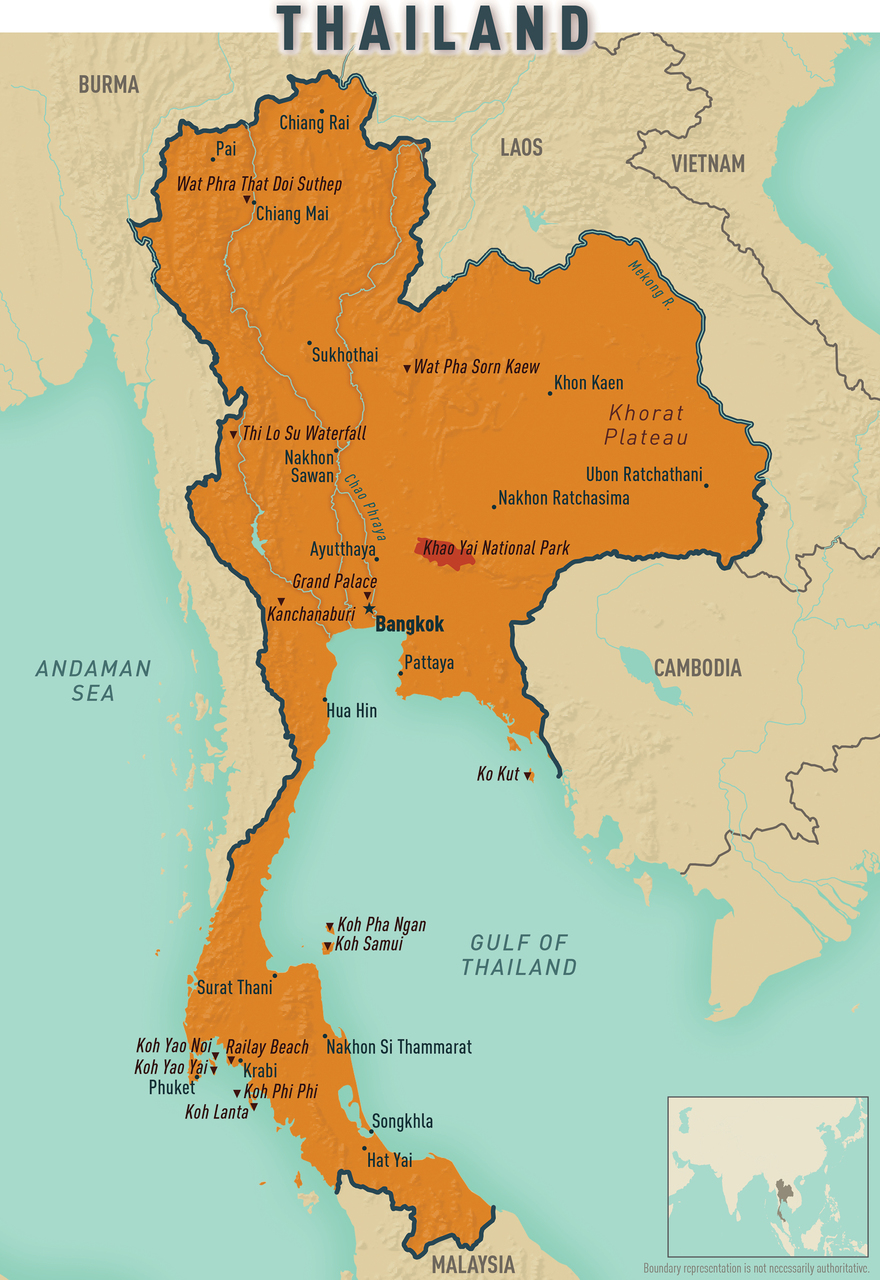
View Larger Figure
All travelers should be up to date on their routine vaccinations, including seasonal influenza. In addition, vaccination against hepatitis A and hepatitis B is strongly recommended. Consider Japanese encephalitis (JE) and typhoid fever vaccines based on the traveler’s potential risk during a visit to, or residence in, Thailand.
Enteric Infections & Diseases
Active cholera transmission has been infrequently reported from Thailand in recent years. For current recommendations for travelers to Thailand , see the Centers for Disease Control and Prevention (CDC) Travelers’ Health website.
Travelers’ Diarrhea
Thailand’s street food is convenient, delicious, and inexpensive. Unfortunately, it also can be a source of travelers’ diarrhea (TD) because lack of clean running water in outdoor eateries precludes good hand and food preparation hygiene. For travelers determined to experience Thai street food, the risk for foodborne illness might be mitigated to some degree by following some basic food and water safety precautions. For instance, visit only restaurants or food stalls that cook food to order, avoid raw or undercooked food, eat only steaming hot food served on new disposable dishes, avoid raw garnishes, eat fruit that you peel yourself, and only drink beverages from sealed containers (see Sec. 2, Ch. 8, Food & Water Precautions ). For further information about travelers’ diarrhea, see Sec. 2, Ch. 6, Travelers’ Diarrhea . Fluoroquinolone-resistant enteric pathogens are widespread in Thailand and other areas of Southeast Asia.
Typhoid Fever
Typhoid fever is endemic to Thailand. Incidence has been declining, however, and was estimated to be 3 cases per 100,000 population in 2014. People planning extended stays or travel to remote parts of the country should be vaccinated against typhoid (see Sec. 5, Part 1, Ch. 24, Typhoid & Paratyphoid Fever ).
Respiratory Infections & Diseases
Coronavirus disease 2019.
All travelers going to Thailand should be up to date with their COVID-19 vaccines .
Tuberculosis
Thailand has a high burden of tuberculosis (TB). Immunocompromised travelers who visit Thailand for extended visits could be at increased risk for TB. Travelers should avoid people known to have active TB, and refrain from consuming unpasteurized dairy products (see Sec. 5, Part 1, Ch. 22, Tuberculosis ).
Sexually Transmitted Infections & HIV
Thailand is a destination for tourists seeking sex (see Sec. 9, Ch. 12, Sex & Travel ). Although commercial sex work is illegal, it is practiced in many places in Thailand. Visitors to Thailand’s red-light districts should be aware that these areas have been associated with human trafficking.
In 2019, ≈470,000 people were living with HIV/AIDS in Thailand. The number of new HIV infections reported nationwide each year decreased during 2010–2019. A 100% condom program, which encourages sex workers and their customers to always use condoms, has helped slow the spread of HIV and other sexually transmitted infections (STIs). Nonetheless, HIV infection remains concentrated in many populations. In 2020, an estimated 12% of men who have sex with men, and 3% of sex workers (≈4% of male sex workers and 1.7% of female sex workers) in Thailand were living with HIV.
Travelers should be aware of the risks of acquiring HIV and other STIs in Thailand, always use condoms during sex, and avoid injecting drugs or sharing needles. Travelers whose practices put them at high risk for HIV infection should discuss preexposure prophylaxis with their primary care and travel medicine providers (see Sec. 5, Part 2, Ch. 11, Human Immunodeficiency Virus / HIV ).
Soil- & Waterborne Infections
Leptospirosis & melioidosis.
Leptospirosis (see Sec. 5, Part 1, Ch. 10, Leptospirosis ) cases occur mainly in the southern and northeastern regions of the country; melioidosis (see Sec. 5, Part 1, Ch. 12, Melioidosis ) is highly endemic to northeast Thailand. For both diseases, most cases occur during the rainy season, July–October. Adventure travelers can be at increased risk for these diseases because their activities expose them to soil and surface water. Advise travelers visiting endemic areas to avoid contact with soil and water and to ensure that any open wounds are covered to prevent exposure. When contact cannot be avoided, travelers should wear protective clothing and footwear to reduce their exposure risk. Counsel travelers to immediately and thoroughly clean abrasions, burns, or lacerations contaminated with soil or surface water.
Vectorborne Diseases
Dengue & zika.
Dengue (see Sec. 5, Part 2, Ch. 4, Dengue ) is endemic throughout Thailand. Large epidemics occur every several years. Peak transmission is during the rainy season, although cases are reported year-round even in non-epidemic years. Travelers to Thailand should take measures to protect themselves from mosquito bites to prevent dengue (see Sec. 4, Ch. 6, Mosquitoes, Ticks & Other Arthropods ).
Transmission of Zika virus (see Sec. 5, Part 2, Ch. 27, Zika ) has occurred in Thailand, but no evidence suggests recent outbreaks. Because of the risk for birth defects in infants born to people infected with Zika during pregnancy, however, travelers who are pregnant or trying to become pregnant should review the most recent CDC recommendations .
Japanese Encephalitis
JE is endemic to many parts of Thailand outside the capital. Transmission occurs year-round, with seasonal epidemics occurring in the northern provinces during May–October. Although most outbreaks occur in the Chiang Mai valley, cases have occurred in travelers who visited resorts or coastal areas in southern Thailand. JE vaccine is recommended for travelers who plan to visit Thailand for ≥1 month and should be considered for people visiting for a shorter period who have an increased risk for JE virus exposure due to their itineraries or activities (see Sec. 5, Part 2, Ch. 13, Japanese Encephalitis ).
Malaria is endemic to specific areas in Thailand, particularly the rural, forested areas bordering Burma (Myanmar), Cambodia, and Laos, and the provinces of the far south along the border with Malaysia. Transmission is year-round, peaking during the rainy season, with a second, smaller peak in December. Approximately 80% of cases are due to Plasmodium vivax ; <20% are due to P. falciparum . CDC recommends protection against mosquito bites and antimalarial prophylaxis for travelers visiting any of the endemic areas (see Sec. 2, Ch. 5, Yellow Fever Vaccine and Malaria Prevention Information, by Country ; Sec. 4, Ch. 6, Mosquitoes, Ticks & Other Arthropods ; and Sec. 5, Part 3, Ch. 16, Malaria ). Atovaquone-proguanil, doxycycline, or tafenoquine are the recommended prophylactic antimalarial drugs for travelers going to malaria-endemic areas in Thailand; mosquito avoidance only (no chemoprophylaxis) is recommended for people traveling to areas where cases of malaria transmission are rare to few (e.g., Bangkok, Chiang Mai, Phuket).
Map 2-16 Malaria prevention in Thailand
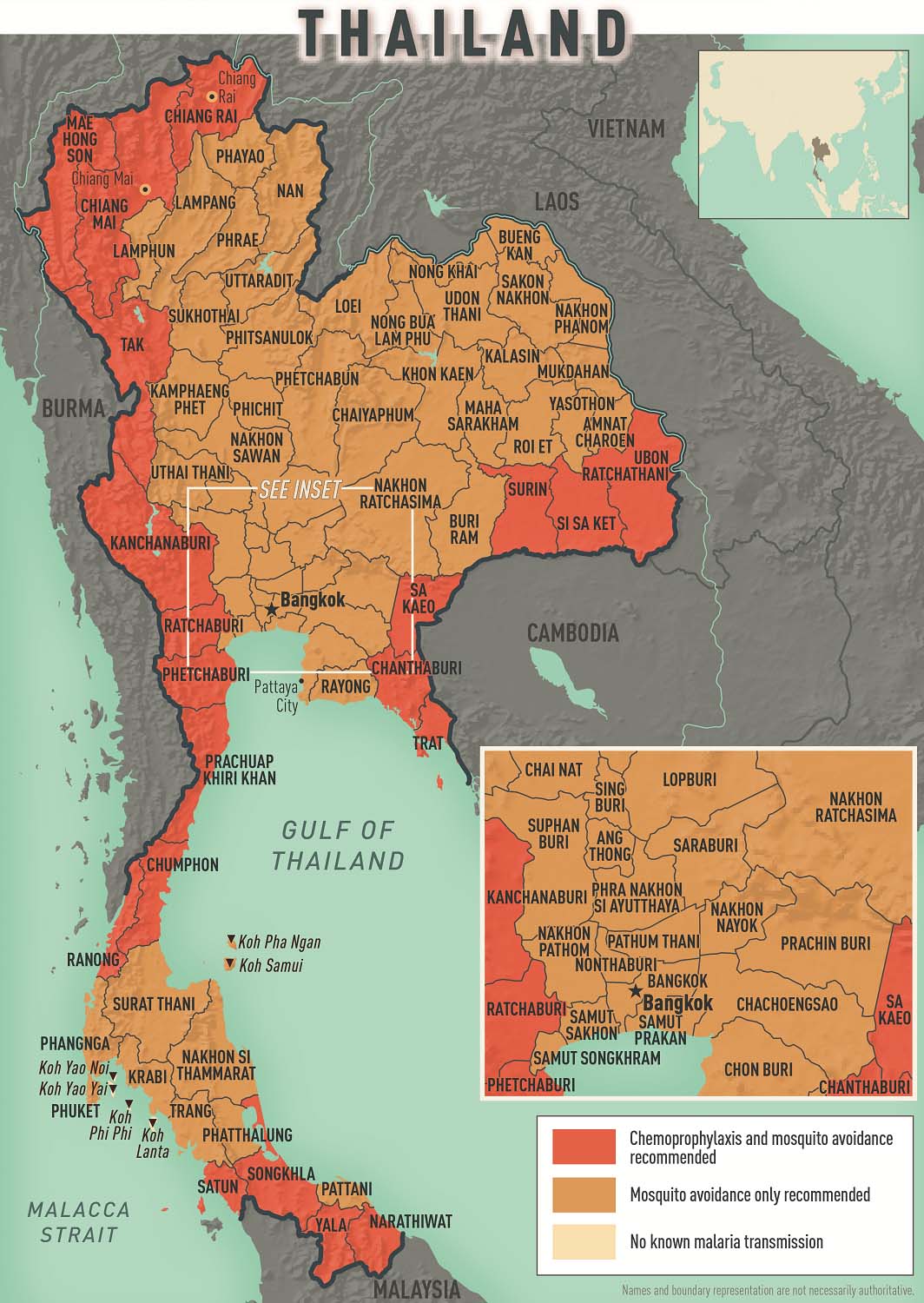
View Larger
Air Quality
Air quality in Thailand varies by province and fluctuates throughout the year, with seasonal smog becoming an increasing health concern in some areas of the country (see Sec. 4, Ch. 3, Air Quality & Ionizing Radiation ). The air quality in several provinces (Bangkok, Chiang Mai, Chiang Rai, Khon Kaen, Lampang, Lamphun, Mae Hong Son, Nan, and Samut Sakhon) has exceeded Thai and US government daily standards for fine particulate matter (PM2.5) during parts of the year. In Chiang Mai and other northern provinces, air quality is frequently poor during February–April because of agricultural burning and forest fires.
Animal Bites & Rabies
Government-sponsored mass vaccination campaigns for cats and dogs have reduced the prevalence of rabies in Thailand, but a small risk persists. Preexposure vaccination is recommended only for travelers whose occupation puts them at risk for exposure (e.g., veterinarians) or people who will be traveling to areas where immediate access to care and rabies biologics will be difficult (see Sec. 5, Part 2, Ch. 18, Rabies ). Rabies vaccine for preexposure and postexposure prophylaxis and human rabies immune globulin are readily available in all provincial and most district hospitals throughout Thailand.
Climate & Sun Exposure
Because Thailand is close to the equator, the climate is often hot and humid (see Sec. 4, Ch. 1, Sun Exposure , and Sec. 4, Ch. 2, Extremes of Temperature ). Flooding is always a possibility, and various regions are prone to flash floods. Monsoon rains typically fall during July–October and can last until relatively cooler, drier weather begins in November, making November–February a popular time of year to visit.
Natural Disasters
Tsunamis are a risk in Thailand; the 2004 tsunami was the deadliest on record. Two other tsunamis have hit Thailand since 2004, resulting in ≈8,000 deaths.
The crime rate in Thailand exceeds that of some other countries in Asia. Although most crime involves petty theft, crime related to drug use and the illegal drug trade, gambling, and human trafficking and prostitution also occur. And while more violent crime (e.g., homicide, rape) involving visitors is uncommon in Thailand, it has happened.
Political Unrest
Thailand has experienced political unrest throughout the country and ethnonationalist violence in the southern provinces. In 2014, a caretaker military government was established to maintain peace, develop a constitution, and facilitate democratic elections. The country remains politically divided, however, and demonstrations and government protests continue. Prudent travelers should avoid these gatherings because no one can predict whether they will stay peaceful or turn violent (see Sec. 4, Ch. 11, Safety & Security Overseas ).
To find out if, when, and where political protests might occur, travelers should monitor the local news, social media outlets, and the US Embassy & Consulate in Thailand website. In addition, by enrolling with the US Department of State’s Smart Traveler Enrollment Program , US citizens and nationals traveling and living in Thailand receive safety alerts from the US embassy; it also enables the US embassy to contact them in the event of an emergency.
Recent terrorism-related incidents in Thailand have been related to the South Thailand insurgency, a separatist group with roots in ethnic and religious tensions. The insurgency has been ongoing for several decades and is concentrated in 4 provinces (Narathiwat, Pattani, Songkhla, Yala) in the far south of the country, near the Malaysian border. Martial law is enforced in these provinces. Due to safety concerns, US government employees need official authorization to travel to these areas, and the US embassy in Thailand strongly discourages all other Americans from going. The Royal Thai Government has taken active measures to counter terrorism through legislation, capacity-building, and communication and collaboration with other countries in the region.
Traffic-Related Injuries
Traffic accidents are common in Thailand. According to the World Health Organization, in 2018, Thailand had one of the world’s highest traffic-related fatality rates , due in large part to reckless driving. Approximately 20,000 motor vehicle deaths occur in Thailand each year. Motorcycles, a cheap and popular mode of travel, are among the most vulnerable vehicles on the road. During 2019–2021, 85% of road accidents involved motorcycles or scooters, and a substantial proportion (73% in 2012) of motor vehicle deaths are due to motorcycle and scooter crashes. Travelers should avoid riding motorbikes, including motorbike taxis, but if they must ride, they should wear a helmet. Travelers also should fasten seat belts when riding in cars (see Sec. 8, Ch. 5, Road & Traffic Safety ).
Health care in Thailand is generally considered to be of good quality and less costly than in many high-income countries. Approximately 20% of hospitals are private, and many accept online registration and have English-speaking staff. Most major medical centers are in larger metropolitan areas. In rural areas, availability and quality of medical care is more limited.
Medical Tourism
Medical tourism to Thailand increased during 2010–2019. The cost of medical or surgical treatment is lower, and the level of care is considered comparable to that of many places in the United States. Thailand is among the top medical tourism destinations worldwide. Travelers intending to obtain medical care abroad should research the facilities at their destination; learn about health insurance coverage, travel regulations, and requirements for visitors seeking medical care in Thailand; and consult with their primary care physician and a travel medicine specialist in advance of their trip (see Sec. 6, Ch. 4, Medical Tourism ).
The following authors contributed to the previous version of this chapter: John R. MacArthur, Joshua Mott, Sopon Iamsirithaworn
Bibliography
AIDSinfo. Global dataset on HIV epidemiology and response. Available from: https://aidsinfo.unaids.org .
Hinjoy S, Hantrakun V, Kongyu S, Kaewrakmuk J, Wangrangsimakul T, Jitsuronk S, et al. Melioidosis in Thailand: present and future. Trop Med Infect Dis. 2018;32(2):38.
US Central Intelligence Agency. The world fact book 2021; East and Southeast Asia: Thailand. Washington, DC: The Agency; 2021. Available from: www.cia.gov/the-world-factbook/countries/thailand .
US Department of State, Bureau of Consular Affairs. Travel and transportation: Thailand. Available from: https://travel.state.gov/content/travel/en/international-travel/International-Travel-Country-Information-Pages/Thailand.html .
World Health Organization. Global status report on road safety 2018. Geneva: The Organization; 2018. Available from: www.who.int/publications/i/item/9789241565684 .
World Health Organization. Towards a rabies-free Thailand by 2020. Available from: www.who.int/news-room/feature-stories/detail/towards-a-rabies-free-thailand-by-2020 .
File Formats Help:
- Adobe PDF file
- Microsoft PowerPoint file
- Microsoft Word file
- Microsoft Excel file
- Audio/Video file
- Apple Quicktime file
- RealPlayer file
- Zip Archive file
Exit Notification / Disclaimer Policy
- The Centers for Disease Control and Prevention (CDC) cannot attest to the accuracy of a non-federal website.
- Linking to a non-federal website does not constitute an endorsement by CDC or any of its employees of the sponsors or the information and products presented on the website.
- You will be subject to the destination website's privacy policy when you follow the link.
- CDC is not responsible for Section 508 compliance (accessibility) on other federal or private website.
Situation in Haiti April 5, 2024
U.s. citizens in haiti, update april 12, 2024, information for u.s. citizens in the middle east.
- Travel Advisories |
- Contact Us |
- MyTravelGov |
Find U.S. Embassies & Consulates
Travel.state.gov, congressional liaison, special issuance agency, u.s. passports, international travel, intercountry adoption, international parental child abduction, records and authentications, popular links, travel advisories, mytravelgov, stay connected, legal resources, legal information, info for u.s. law enforcement, replace or certify documents.
Share this page:
Thailand Travel Advisory
Travel advisory july 24, 2023, thailand - level 1: exercise normal precautions.
Reissued with obsolete COVID-19 page links removed.
Exercise normal precautions in Thailand. Some areas have increased risk. Read the entire Travel Advisory.
Reconsider travel to:
- Yala, Pattani, Narathiwat, and Songkhla provinces due to civil unrest associated with ongoing insurgent activities.
Read the country information page for additional information on travel to Thailand.
If you decide to travel to Thailand:
- Enroll in the Smart Traveler Enrollment Program (STEP) to receive Alerts and make it easier to locate you in an emergency.
- Follow the Department of State on Facebook and Twitter .
- Review the Country Security Report for Thailand.
- Have evacuation plans that do not rely on U.S. government assistance.
- Visit the CDC page for the latest Travel Health Information related to your travel.
- Prepare a contingency plan for emergency situations. Review the Traveler’s Checklist .
Yala, Pattani, Narathiwat, and Songkhla Provinces – Level 3: Reconsider Travel
Periodic violence directed mostly at Thai government interests by a domestic insurgency continues to affect security in the southernmost provinces of Yala, Pattani, Narathiwat, and Songkhla. In Songkhla, the insurgency is most active in the districts of Chana, Thepha, Nathawat, and Saba Yoi. U.S. citizens are at risk of death or injury due to the possibility of indiscriminate attacks in public places.
The U.S. government has limited ability to provide emergency services to U.S. citizens in these provinces as U.S government employees must obtain special authorization to travel to these provinces.
Visit our website for Travel to High-Risk Areas .
Travel Advisory Levels
Assistance for u.s. citizens, thailand map, search for travel advisories, external link.
You are about to leave travel.state.gov for an external website that is not maintained by the U.S. Department of State.
Links to external websites are provided as a convenience and should not be construed as an endorsement by the U.S. Department of State of the views or products contained therein. If you wish to remain on travel.state.gov, click the "cancel" message.
You are about to visit:
An official website of the United States government
The .gov means it’s official. Federal government websites often end in .gov or .mil. Before sharing sensitive information, make sure you’re on a federal government site.
The site is secure. The https:// ensures that you are connecting to the official website and that any information you provide is encrypted and transmitted securely.
- Publications
- Account settings
Preview improvements coming to the PMC website in October 2024. Learn More or Try it out now .
- Advanced Search
- Journal List
- Bioengineered
- v.13(2); 2022
COVID-19 in Southeast Asia: current status and perspectives
Dinh-toi chu.
a Center for Biomedicine and Community Health, International School, Vietnam National University, Hanoi, Vietnam
b Department of Natural Science and Technology, International School, Vietnam National University, Hanoi, Vietnam
Suong-Mai Vu Ngoc
Yen-vy nguyen thi, thuy-tien ho, van-thuan hoang.
c Thai Binh University of Medicine and Pharmacy, Thai Binh, Vietnam
Vijai Singh
d Department of Biosciences, School of Science, Indrashil University, Rajpur, India
Jaffar A. Al-Tawfiq
e Infectious Disease Unit, Specialty Internal Medicine, Johns Hopkins Aramco Healthcare, Dhahran, Saudi Arabia
f Department of Medicine, Indiana University School of Medicine, Indianapolis, IN, USA
g Department of Medicine, Johns Hopkins University School of Medicine, Baltimore, MD, USA
Coronavirus Disease-2019 (COVID-19) has spread globally with catastrophic damages to the public health, social and economy since the beginning of the outbreak. In 2020, Southeast Asia proved that it could prevent the worst effects of a pandemic through the closure of activities and borders and movement restriction, as well as social distancing. Nevertheless, with the occurrence of the common variants of concern (VOCs), especially Alpha (B.1.1.7), Beta (B.1.351), Delta (B.1.617.2), Southeast Asia is facing a significant increase in the Severe Acute Respiratory Syndrome Coronavirus 2 (SARS-CoV-2) infections. Now, the area also has the threats of the spreading out of the dangerous variant – Omicron (B.1.1.529) from other close countries or regions. COVID-19 countermeasures such as closures and social distancing seem to be insufficient. Moreover, Southeast Asia is being held back by a shortage of vaccines and other medical resources. This work focuses on describing the COVID-19 situation, the virus variants, and the coverage of COVID-19 vaccination in the area. We also provide perspectives on the COVID-19 vaccine distribution, protecting the economic capitals, developing the green zone, and the importance of finding more vaccine supplies in Southeast Asia.
Introduction
COVID-19 is an acute respiratory disease caused by a new SARS-CoV-2. It was first emerged on 31 December 2019 in Wuhan city, China [ 1 ]. On 13 January 2020 coronavirus infections outside China were reported
[ 2 ]. SARS-CoV-2 infections can range from asymptomatic to acute respiratory distress [ 3 ]. As of 17 September 2021 the World Health Organization (WHO) recorded 227,951,739 COVID-19 infections globally and 4,686,522 deaths.
The diversity of the SARS-CoV-2 was initially reported to be very low [ 2 ]. However, since the summer of 2020, new variants have been notified, and the WHO classifies new SARS-CoV-2 virus variants as variants of concern (VOCs) and variants of interest (VOIs). VOCs have the potential to cause increased transmissibility, increased virulence, altered clinical presentation, and reduced the effectiveness of social and public health measures as well as available diagnoses, vaccines, and treatments. The VOCs include Alpha, Beta, Gamma, and Delta, and now, Omicron [ 4 ]. A VOC could be increased transmission and mortality [ 5 ] and reduce the effectiveness of vaccines, therapies, or other medical measures. A VOI is a variant with a genetic capability that affects the characteristics of the virus [ 5 ].
Alpha (B.1.1.7) variant was first appeared in the United Kingdom (UK) [ 6 ]. It was reported to be 43% to 82% more transmissible, surpassing the previously existing variants to become the predominant SARS-CoV-2 variant in the UK [ 7 ]. Beta (B.1.351) was first found in South Africa. This variant increases transmission risk and reduces neutralization by monoclonal antibody therapy, convalescent sera, and post-vaccination sera [ 7 ]. Gamma (P.1) was first identified in travelers from Brazil to Japan, and Delta (B.1.617.2) was first found in India [ 8 ], spreading faster than other variants. The Delta has ten mutations that mutated protein [ 7 ], and this variant is up to 50% more transmissible than the Alpha variant [ 9 ]. Delta was also found in the United States just a few months ago but now accounted for more than 90% of all COVID-19 cases [ 10 ]. In addition, the Delta variants also became the most common variant in the UK [ 11 ]. On the other hand, VOIs including Eta, Iota, Kappa, Lambda [ 4 ] have genetic changes that affect viral characteristics such as transmissibility, disease severity, immune escape, diagnostic or therapeutic escape. In addition, these variants have been identified as a significant cause of community transmission or clusters of COVID-19 in multiple countries, with increasing case numbers over time and represent a new risk to global public health. Both VOCs and VOIs are very risky. Significantly, the most concerned variant of SARS-CoV-2 named Omicron (B.1.1.529), reported to WHO from South Africa on 24 November 2021 leads to a global urgent public health alert [ 12 , 13 ].
Suspected or confirmed cases of COVID-19 require precautions to be taken to minimize the spread of the disease to the surrounding community. Both the patient and people in contact must take precautions [ 14 ]. To avoid spreading the disease, confirmed or suspected COVID-19 patients should avoid direct contact with others. They were also recommended to wear a mask [ 14 ]. Aerosol therapy using a nebulizer while on mechanical ventilation can also be a source of the spread of the COVID-19 infection. The use of aerosol generators is therefore not recommended
[ 15 ]. In addition, methods to protect people from COVID-19 recommended by the Centers for Disease Control and Prevention [ 16 ] are: getting vaccinated, diligently washing your hands, stay away from crowds and places where the air is poorly ventilated. Moreover, covering coughs, sneezes by wearing a mask or using tissues, cleaning the house, household items, regularly monitoring the health are nonspecific preventive measures. In addition, the WHO also recommends if COVID-19 is spreading in the community, stay safe by taking simple precautions. Maintenance at a distance of at least 2 meters from others may reduce the risk of infection when they cough, sneeze, or speak. In case of suspected symptoms for COVID-19, contact medical centers are needed [ 17 ].
COVID-19 has caused a health crisis for the citizens in Southeast Asian countries, which are Brunei, Burma (Myanmar), Cambodia, Timor-Leste, Indonesia, Laos, Malaysia, the Philippines, Singapore, Thailand, and Vietnam. Their governments have policies to respond and manage risks as well as guidelines on vaccines for the citizens [ 18 ]. This review focuses on describing the COVID-19 situation in Southeast Asia. We also provide perspectives on the COVID-19 vaccine distribution, protecting the economic capitals, developing the green zone, and the importance of finding more vaccine supplies in these countries.
COVID-19 epidemics in Southeast Asia
Current status of covid-19.
At the end of December 2019 in Wuhan City, Hubei Province, China, ‘pneumonia of unknown cause’ cases continuously appeared [ 19 ]. Considering that information, the WHO requested the Chinese authorities provide information and conduct investigations to determine the cause of atypical pneumonia reported in Wuhan [ 20 ]. Through research, Chinese scientists have determined that the outbreak in Wuhan was caused by a new type of coronavirus [ 20 ]. They have found up to 79.5% gene sequence similarity with the previous SARS-CoV-1 [ 21 ]. This new coronavirus, named 2019-nCoV, is a new clade in the sarbecovirus subfamily, Ortho Corona Virinae. In the coronavirus family, SARS-CoV-2 is the seventh member [ 19 ]. On 11 February 2020 WHO announced an official name for the disease caused by the novel coronavirus as COVID-19. COVID-19 is the third outbreak of human coronavirus disease, following severe acute respiratory distress syndrome (SARS) and the Middle East Respiratory Syndrome Coronavirus (MERS-CoV) [ 22 ].
The first death of the coronavirus was indicated on 9 January 2020 [ 23 ]. Soon after, dozens of non-Chinese infections were reported, including France (23 January 2020) and Algeria (25 February 2020). The epidemic has spread to 123 countries and territories, with global infections exceeding 126,000 cases and more than 4 million deaths since the beginning of the outbreak [ 24 ]. On 11 March 2020 the WHO has issued a statement calling ‘COVID-19’ a ‘Global Pandemic’ [ 24 ].
Southeast Asia is also on the list of regions where the number of COVID-19 infections has significantly increased in recent times [ 25 ]. 13 January 2020 the first confirmed case of the virus in Southeast Asia is a 61-year-old woman from Thailand [ 26 ]. Shortly after that, other countries in Southeast Asia also confirmed the first cases of COVID-19, such as Vietnam on 23 January 2020.
[ 27 ], Malaysia on 25 January 2020 [ 28 ], Cambodia on 27 January 2020 [ 29 ], the Philippines on 30 January 2020 [ 30 ]. Nowadays, Southeast Asia has seen sharp increases in cases and deaths from the disease. As of 17 September 2021 Southeast Asia recorded 11,324,390 confirmed cases and 249,529 deaths [ 17 ]. The case fatality rate CFR in Southeast Asia countries was significantly higher compared to the rate worldwide (3.3% versus 2.1%, p < 0.0001, chi2 test, statistical analysis was carried out using OpenEpi and available data in WHO Coronavirus COVID-19 Dashboard ( Table 1 ). Specifically, Indonesia recorded a total of 4,185,144 cases of SAR-CoV-2 infection, including 140,138 deaths (CFR = 3.3%) [ 31 ]. This country has the most significant number of people infected with COVID-19 in Southeast Asia, followed by the Philippines, with 2,040,343 cases and 33,873 deaths (CFR = 1.6%) [ 31 ]. Singapore and Laos are currently the two countries with the lowest CFR in Southeast Asia (0.1% and 0.1%, respectively) [ 31 ]. Interestingly, Myanmar recorded only 440,741 confirmed cases, but the CFR was highest in the region (3.8%).
Status of COVID-19 pandemic in 11 countries of Southeast Asia
Note: Data were extracted from Worldometers ( https://www.worldometers.info/coronavirus/ ), Our World in Data ( https://ourworldindata.org/covid-vaccinations?country=OWID_WRL ) as of 17 September 2021 and World Population Review ( https://worldpopulationreview.com/continents/asia-population ).
The variants of SARS-CoV2
In the current SARS-CoV-2 pandemic, countries in Southeast Asia have the common occurrence of three strains: Alpha (B.1.1.7), Beta (B.1.351), and Delta (B.1.617.2), which were circulating in original countries, then and rapidly infected people in neighboring countries and worldwide [ 32 ]. At the end of May 2020, one study analyzed 444 SARS-CoV-2 genome sequences available on the GISAID platform from 6 Southeast Asian countries. The author showed that most of the mutations found in this region were also prevalent in North America and European countries, suggesting a possible transmission route [ 33 ]. Like the other parts of the world, this area is facing the threat of the most recent and concerning variant – Omicron, which was first discovered in South Africa on 24 November 2021 [ 12 ]. Still, now on December 03, it is spreading to more than 24 countries in the world, including the countries or regions close to Southeast Asia such as India, Japan, South Korea, and Hong Kong.
Between March 2021 and June 2021, Cambodia and Thailand recorded two VOCs, Alpha and Delta [ 34 ]. In addition, the Beta variant was found in Indonesia and Malaysia. Meanwhile, in Laos, the least affected country by COVID-19, worrisome cases of infected people have begun to appear [ 32 ]. In Malaysia’s 3 rd wave (September 2020) of infections, a new variant named B.1.524 appeared [ 21 ]. Two spike protein mutations, including a common D614G and A701V, have been discovered [ 35 ]. A recent report described nine variants of SARS-CoV-2 with the D614G mutation in Malaysia [ 36 ]. One study reported that variant B.1.466.2 came from Malaysia and B.1.468 from Indonesia [ 36 ]. Another study identified the SARS-CoV-2 strain circulating mainly in Malaysia as strain B, common in East Asia. The other two lines are strain C originating in European countries and strain A from the US and Australia [ 37 ]. A study analyzing SARS-CoV-2 genomes indicated that SARS-CoV-2 variants originated from Europe and Asia in Indonesia. The study also determined the high prevalence of the D614G mutation in the country [ 38 ].
Delta (B.1.1.7) is considered an important variant with the ability to infect far beyond the previous Alpha strain [ 32 ]. It has been present in 135 countries, including Southeast Asian regions such as Vietnam, Indonesia, Malaysia, and Thailand [ 32 , 39 ]. In March 2020, Vietnam recorded COVID-19 cases of the Delta variant [ 40 ]. In January 2021, infections of the B.1.1.7 variant were recorded in 3 provinces of Indonesia [ 41 ]. Delta variant was spread quickly after 2 months from India to Indonesia, which is a significant cause of the record-high number of COVID-19 infections in other countries of this region [ 42 ]. The newest variant, the Omicron (B.1.1.529) is reported to be much faster in terms of spreading than the Delta and other variants, with the doubling time shortened to 2 to 3 days [ 43 ]. The rate of Omicron infection was found to be 3.2 times higher than the Delta [ 44 ]. This variant has been discovered in 9 out of 11 countries in Southeast Asia, with total cases of 2,016 (data taken from 31 December 2021) [ 45 ].
Currently, all three variants, the Alpha, Beta, and Delta, are available in Myanmar. Alpha originated from Singapore and Thailand, while the other two strains came from the East of Thailand and the West of Bangladesh and India [ 32 ]. Variant B.6 was found in samples from Singapore and Malaysia. Two variants, B.1.36.1 and B.1.1, came from India, and one variant, B.1.80, was found in China. Thus, the second transmission phase (August-September 2020) in Myanmar may have originated from the B.1.36 variant since it was found in all tested samples [ 46 ]. A study showed that the overall CFR of COVID-19 in Singapore is lower than that in Japan. It suggests that the circulating SARS-CoV-2 variant in Singapore was associated with a decrease in severity [ 47 ]. In March 2020, a new variant, D614G in Spike protein, was identified. During the first 6 months, Singapore and South Korea were the only two countries in the world that did not report this type of mutation [ 48 ]. A study in Singapore compared the pathogenicity of three VOCs, alpha, beta, and delta, which beta variant is the most dangerous that deserves attention in this country for its lack of oxygen, high ICU treatment rate, and mortality [ 49 ] ( Figure 1 ).

The presence of COVID-19 variants in Southeast Asia . The graph describes the total number of COVID-19 variants in each Southeast Asian country, in which, Brunei (37), Cambodia (607), Indonesia (2457), Malaysia (614), Myanmar (24), Philippines (2249), Singapore (4670), Thailand (1884) and Vietnam (214). The data of Laos and Timor-Leste was not recorded. Data updated to 4 September 2021 Omicron upated on 31 December 2021. Variants are classified according to WHO ( https://www.who.int/en/activities/tracking-SARS-CoV-2-variants/ ). The total number of variants in each country is based on GISAID Southeast Asia data ( https://www.gisaid.org/hcov19-variants/ ).
The COVID-19 vaccination
In the face of a complicated pandemic, vaccines play an important role in ending the COVID-19 pandemic. At the time of writing, 42.8% of the world’s population has received at least one dose of the COVID-19 vaccine [ 50 ]. However, the distribution of vaccines is uneven across countries ( Table 1 ), depending on many factors such as the income levels, population size, vaccines allowed by the Government, as well as the ability to produce vaccines locally ( Figure 2 ). For example, only 1.8% of people in low-income countries have received at least one dose of the vaccine [ 51 ]. Specifically, as of 17 September 2021 77% of the population were fully vaccinated against COVID-19 in Singapore [ 51 ]. Two other countries in Southeast Asia that also have a high percentage of their population fully vaccinated against COVID-19 are Cambodia with 59.0% and Malaysia with 54.8%. The coverage of the COVID-19 vaccine was lowest in Vietnam and Myanmar, with 6.1% and 5.9% population fully vaccinated, respectively ( Table 1 ) [ 51 ]. Interestingly, Table 1 shows that CFR is high in countries with low vaccine coverage, such as Myanmar, Indonesia, and Vietnam ( Table 1 ).

The COVID-19 vaccinations in Southeast Asia . The data updated to 28 December 2021 ( https://ourworldindata.org/covid-vaccinations ). The COVID-19 vaccination data of Laos was not recorded.
According to the most recent data, on 17 September 2021 29.6% of the Southeast Asian population were received the full dose of the vaccine. This rate is lower than the world with 30.4% [ 50 ]. Singapore is the leading country, with 77.0% of the population being vaccinated with full doses of vaccine, deploying 4.65 million doses, and 4.5 million people are fully vaccinated [ 51 , 52 ]. 59.0% and 54.8% of the total population in Cambodia and Malaysia received the full dose, respectively [ 51 , 52 ]. Cambodia has provided 19.2 million vaccine doses, in which 11.6 million people out of the country’s total population have been fully vaccinated [ 51 , 52 ]. Malaysia has vaccinated more than 21 million doses, of which 18.1 million people have met the number of injections [ 51 , 52 ]. Laos and Brunei have 25.2% and 33.7% of the total fully vaccinated population, respectively. Laos has injected 2.7 million doses, of which 1.9 million people are fully vaccinated [ 51 , 52 ]. In addition, Brunei has the advantage of a smaller population, provided a total of 237.015 doses of the vaccine, of which 148.587 people were fully vaccinated [ 51 , 52 ]. Other countries in Southeast Asia with a percentage of the total population fully vaccinated are Indonesia (15.8%), the Philippines (11.3%), and Thailand (19.0%) [ 51 , 52 ]. Indonesia’s population growth rate changes rapidly and has provided 77.4 million vaccine doses, but only 44.1 million people have been fully vaccinated [ 51 , 52 ]. The Philippines and Thailand have significantly lower populations, with 18.7 million and 28.4 million vaccine doses, meeting vaccine requirements for 12.6 million and 14.3 million people, respectively [ 51 , 52 ]. Vietnam and Myanmar are at the bottom of the list, with only 6.1% and 5.9% of the total population fully vaccinated [ 51 , 52 ]. Vietnam has now provided 26.3 million doses of vaccine, with 6.0 million people vaccinated with 2 doses [ 51 , 52 ]. In Myanmar, 4.9 million doses of vaccine are being deployed to the people, of which 3.2 million people are guaranteed to be fully vaccinated [ 51 , 52 ]. Most Southeast Asian countries have access to vaccines, including Pfizer/BioNTech, Moderna, Oxford/AstraZeneca, Jassen (Johnson & Johnson), Covishield, Sputnik V, Sinopharm (Beijing), and Sinovac [ 51 , 52 ]. The Philippines uses some other products such as Sinopharm (Beijing, Wuhan), Sputnik (V, Light), and Covaxin [ 51 , 52 ] ( Table 1 ). With a global shortage of vaccines, low – and middle-income countries in Asia have yet to deploy full doses to the entire population. However, this is considered the most effective method at the moment [ 53 ]. A significant reason for vaccine shortages in Southeast Asian countries is affordability and supply chain constraints. All countries need a vast amount of vaccine, making it challenging to access manufacturers in low and middle-income countries. There is an inequality in access to vaccine resources in different parts of Southeast Asia. Most countries in Southeast Asia are interested in finding cheap vaccine manufacturers, investing in many cold storages with a maximum temperature of −70 to −80°C to store vaccines, allowing equal access to vaccines by people in different regions of the country
Perspectives for controlling COVID-19 in Southeast Asia
Effective delivery and the use of covid-19 vaccine.
In 2020, Southeast Asia proved that it could prevent the worst effects of the pandemic through the closure and movement restriction, as well as social distancing [ 55 , 56 ]. Nevertheless, with the increase in highly infectious variants nowadays, these measures seem insufficient to prevent COVID-19 effectively. Southeast Asia needs robust vaccination programs to keep up with new variants. However, Southeast Asia is being held back by a shortage of vaccines and other medical resources. Low-income countries in Southeast Asia will need significant support from external donors, not only for vaccines but also for accelerating vaccination. The International Federation of Pharmaceutical Manufacturers & Associations [ 57 ] had estimated that more than three billion doses of the vaccine would be produced worldwide by the end of June 2021 [ 57 ]; however, developed countries have monopolized the vaccine. As of mid-May 2021, only 0.3% of all vaccines used globally went to low-income countries [ 58 ]. Southeast Asia has been altogether subject to outer providers for its immunization programs.
China immediately arose as one of the most supportive source nations for the area, with the Sinovac vaccines in Indonesia in December 2020. Other worldwide vaccine makers such as the USA, European Union, Japan, and Australia are also mentioned with direct orders from Southeast Asia and the COVAX initiative [ 59 ]. The COVAX facility was established to promote the development and production of the COVID-19 vaccine and ensure fair and equitable access to all countries in the world [ 60 ]. Low-income countries are supported by COVAX Advance Market Commitment (COVAX/AMC) [ 61 ]. Cambodia, Indonesia, Laos, Myanmar, Philippines, Timor-Leste, and Vietnam are qualified nations under the COVAX/AMC arrangement [ 57 , 62 ]. Furthermore, Southeast Asia is additionally moving to decrease its reliance on outer makers. Vietnam, Indonesia, and Thailand are developing their vaccines [ 9 , 63 , 64 ]. Utilizing all mechanisms to get the vaccine is essential for the time being in Southeast Asia. Moreover, countries can consider buying highly effective vaccines made in Southeast Asia, such as vaccines from Vietnam.
On the other hand, effective vaccines and rational distribution are also leading concerns in Southeast Asia. States should consider the vaccine to priority target groups to ensure that the country is stable during a long-term epidemic. The priority group should be the army, healthcare providers, and other essential workers, with whom the persons are more likely to spread this disease due to living profiles and their work. In the next phase, the vaccine should be given to the elderly over 65 years old, people aged 18–64 years with comorbidities or with high-risk for severe infection, and non–healthcare essential workers. However, one obstacle is that non-healthcare essential workers are usually people with low economic conditions, such as garbage collectors, shippers, and supermarket checkout workers. To sum up, like the rest of the world, Southeast Asia will have to make complex changes to live with COVID-19. They also need a clear plan and strategy to avoid wasting vaccine resources. Furthermore, the economic, ethical, and epidemiological considerations are essential. It is necessary to have multi-sectoral coordination and multi-national coordination to use vaccines economically and effectively.
Protection of the most important economic and administrative capitals
Shaken by the pandemic and its economic costs, Southeast Asia faced a decade of uncertainty after a long period of stability and relative economic growth ( Figure 3 ). Waves of COVID-19 undermined Thailand’s economy in the first half of 2021. This pandemic has caused a 2.6% economic contraction in the first quarter of 2021 after a 6.1% decline in GDP in 2020 in Thailand. This is one of the steepest declines among the Association of Southeast Asian Nations (ASEAN). Meanwhile, the exports of services fell 74.8% yearly as Thailand’s border remained closed to most tourists [ 17 , 64 ]. Cambodia alone lost an estimated $3 billion in tourism revenue in 2020. According to the Minister of Tourism in Cambodia, Cambodia’s most visited tourist destination saw a 45.6% decline in tourist numbers in April 2020 and a 99.6% decline year on year [ 65 ]. About 2,956 businesses are associated with tourism, leaving 45,405 unemployed [ 65 ]. A total of 433 tourism-related companies and enterprises across the country have been temporarily closed. Vietnam’s Gross Domestic Product (GDP) increased by only 1.81% in the first haft of 2020, the lowest level in the past 30 years [ 66 ].

Forecasted GDP growth rate in Southeast Asia by country from 2020 to 2021 . Data source ( https://www.statista.com/statistics/621011/forecasted-gross-domestic-product-growth-rate-in-southeast-asia-2017/ ).
The road to recovery in most countries in this region will be long and difficult. The speed of economic recovery in Southeast Asia will depend on the global trajectory of the pandemic and the success of vaccine development. Therefore, it is necessary to focus on protecting the most important economic and administrative capitals, the economic locomotives of countries, which play a crucial role in their economy. If each country’s financial and administrative capital falls to the COVID-19 outbreak, the whole country will fall. Southeast Asian countries should look for vaccines as much as possible in the administrative capitals and the most important economic. The support of governments worldwide for health and vaccination programs in Southeast Asia seems to be the best investment to save lives and ensure continued economic recovery and societal stability in the region.
Development and protection of the green zones
Green zoning COVID-19 areas have been considered an efficient way to limit the spread of coronavirus infection. This method uses colors to illustrate the epidemiological conditions of a territory. For example, green zones indicate that the epidemic is under control, while red zones point out the opposite. At first, the green zoning method was being applied in hospital wards, where they could mark the patients with COVID-19 infections (red zone) and areas for healthcare providers, as well as medical equipment (green zone) [ 67 ]. Now, we can see the applications of green zones as a COVID-19 indicator in a country or region [ 68 ]. Green zoning consists of four key steps, which are (1) divide each country/city into smaller zones, (2) use common epidemiological to evaluate the zone is either green or red, (3) have suitable public health measures depending on the zone’s color, and (4) permit transporting within green zones, but with a particular health condition (fully vaccinated, negative on the COVID-19 test, etc.) [ 69 ].
For example, in Vietnam, Hanoi and Ho Chi Minh City are the only cities that apply green and red zones because these are the two major cities in Vietnam. The zones are being divided according to the districts ( Figure 4 ). Within the green zones, public places are allowed to be opened, and people are freely traveling inside the green areas, with mandatory use of masks. Individuals transporting from the red zone must have government-issued paper, as well as a negative test of SARS-CoV-2 within the last 72 hours or have already got 2 doses of COVID-19 vaccines.

A demonstration of the marking of the green zone areas in Hanoi (a) and Ho Chi Minh city (b). (a) In Hanoi, the green zones are designated as ‘blue’ (0 cases of COVID-19). Yellow indicates 1–5 cases of COVID-19; Orange indicates 6–20 cases, and red shows more than 20 cases. The figure was taken from ( https://covidmaps.hanoi.gov.vn/?page=home ), data was shown as of 3 September 2021. (b) Ho Chi Minh city uses green, Orange, and red color indicators. There is also an appearance of the ‘nearly green zone,’ which are areas with very few cases of COVID-19. The figure was taken from ( https://bando.tphcm.gov.vn/ ), data was recorded as of 3 September 2021.
Green zones contribute a significant impact for eradicating COVID-19 in Southeast Asia. Therefore, it is crucial to develop and protect the green zones, both regional and national. Especially with the rapid spreading of the Omicron variant, green-zoning is one of the critical factors to prevent the increase of this variant since its likelihood of direct infection is 21.6%. In comparison, the Delta is 10.7% [ 44 ]. Development and protection of the green zones could mean: (1) Restrict traveling from red zone areas to green zone areas and strictly monitor travelers from the red zones. In order to permit inside the green zones, people are coming from contaminated sites are required to take the COVID-19 test at least 48 hours before traveling, with negative results [ 70 ] or need to be fully vaccinated against the coronavirus. Furthermore, quarantine may be of value in limiting the spread of the virus to green zones regions, which are 14–21 days for people who tested negative for coronavirus and 7 days for fully vaccinated people. During quarantine, patients needed to be taken care of and observed by medical experts and tested with COVID-19 several times. And (2) Restrict activities within the green zone regions. Although the green zones are marked as the ‘save zones’ with manageable cases of COVID-19, it is critical to note that there will be possible occasional outbreaks. However, public places are allowed to be opened with a limited of people. Furthermore, all citizens in the green zones should be required to wear masks when they are going out and comply with all the safety measures for protecting themselves from COVID-19, such as washing hands, avoiding touching face, and social distancing.
Seeking more vaccine supplies and developing domestic vaccines
With the high demand for vaccination domestically, scientists in Southeast Asia are sparing no effort in developing domestic vaccines. However, until the present day, only four Southeast Asia are researching and developing their vaccine: Vietnam, Thailand, Indonesia, and Singapore. The Minister of Research and Technology in Indonesia is developing a domestic vaccine, an S subunit vaccine named ‘Merah Putih’ [ 56 ]. However, this vaccine is still pre-clinical, estimating phase 3 clinical trials in 2022 [ 63 ]. Thailand is about to launch its vaccine using mRNA technology, the ‘ChulaCov19’. It has been shown to have a promising result on mice and primate models, and phase 1 of the clinical trials was planned for September 2021 [ 71 ]. The Mahidol University in Thailand is also developing a vaccine called ‘Butanvac,’ in phase 2 of the clinical trials in Thailand and Brazil [ 72 ]. The COVID-19 vaccine developed from Singapore, ‘Lunar-COV19,’ uses mRNA technology. This vaccine can elevate titers of neutralizing antibodies after a single injection [ 73 ]. In Vietnam, Nanogen Pharmaceutical Biotechnology JSC is developing the ‘Nanocovax’ vaccine. The vaccine has entered phase 3 of the clinical trials in June 2021 and is expected to be available in the fourth quarter of 2021 [ 74 , 75 ]. Another vaccine is under clinical trial in Vietnam, the ‘Covivac’ vaccine [ 71 ]. Table 2 summarizes all domestic vaccines developed in Southeast Asia ( Table 2 ).
The recent development of the COVID-19 vaccine candidates in some countries in Southeast Asia
As of 17 September 2021 Southeast Asia has recorded a total of 11,324,390 cases of COVID-19 [ 31 ], and this number is increasing every day. Therefore, there is an immediate demand for vaccines among Southeast Asian countries. Because all the domestic-developed vaccines in Southeast Asia are still undergoing clinical trials, finding the vaccine sources from outside is an instant needed. Southeast Asia majorly depends on the COVAX program for its vaccine demands. The potential disadvantage of COVAX is that high-income countries will be the first in line for COVID-19 vaccines once distributed due to the Advance Market Commitment (AMC) agreement. Low – and middle-income countries access to the COVID-19 vaccines will be undermined [ 76 ]. As a result, it is essential for Southeast Asian countries to self-develop and distribute their vaccines. Moreover, requesting for transferring the vaccine technology from developed countries is also crucial for boosting the development and manufacture of COVID-19 vaccines in Southeast Asia. Countries that want to develop cannot completely close their borders. With the opening of trade, virus transmission is inevitable. Therefore, preventing the pandemic is a shared global task.
Conclusion and future outlook
Since the end of 2019, the world has suffered from a global pandemic, the COVID-19. Until today, 4 VOCs and 5 VOIs of the SARS-CoV-2 have been found, each contaminating and harming the human host in different ways. In 11 countries of Southeast Asia, over 11 million people are infected with this virus, and this number is increasing every day. Therefore, administering vaccines for citizens is urgent. The primary source of vaccines for Southeast Asian countries is through the COVAX program. However, the existing challenge is that high-income countries will be first in the vaccine lines, whereas most Southeast Asian countries are middle – and low-income. With a limited source of vaccines, it is necessary to divide people into groups of prioritizing, determining who will take the shot first. Furthermore, the fight to combat this pandemic will be long and arduous. It is essential to protect the economic and administrative capitals. Moreover, to limit the spread of COVID-19 in the country, division of the regions into red and green zones to control the epidemic is also needed. Finally, Southeast Asia is at the bottom of the COVAX program, and with the high vaccine demand, it is crucial to develop domestic-made vaccines. Nevertheless, since most of the self-developed vaccines in Southeast Asia are still only in phases 1 and 2 of the clinical trials, there is immediate importance of finding outside vaccine supplies to push the vaccination among the countries faster and more efficiently.
Acknowledgements
We would like to thank Nguyen Duong Anh Hong and Nguyen Mai Anh (Center for BioMedicine and Community Health, International School, Vietnam National University) for partially collecting references and critical reading of the manuscript.
The authors declare that they have no known competing financial interests or personal relationships that could have influenced the work reported in this paper.
Funding Statement
The author(s) reported there is no funding associated with the work featured in this article.
Research highlights
- COVID-19 has spread globally with catastrophic damages to the public health, social, and economics
- Southeast Asia is facing a significant increase in SARS-CoV-2 infections as the occurrence of several virus variants such as Alpha (B.1.1.7), Beta (B.1.351), and Delta (B.1.617.2).
- Southeast Asia also has dangerous threats by the spreading out of the Omicron (B.1.1.529) variant.
- More COVID-19 vaccine coverage, protecting the economic capitals, and developing the green zone are needed for Southeast Asia.
Authors’ contribution
DTC conceptualized this manuscript. DTC, SMVN, HVT, TTH, VTH, YVNT, VJ, VTH, and AAT wrote the manuscript. DTC, SMVN, HVT, TTH, and VTH prepared the figures and tables. All authors contributed to the revision and discussions of the scope of this work and approved the final manuscript.
Compliance with ethical standards
Conflict of interest All authors declared that they had no conflicts of interest
Abbreviation
Disclosure statement.
No potential conflict of interest was reported by the author(s).
Learn how UpToDate can help you.
Select the option that best describes you
- Medical Professional
- Resident, Fellow, or Student
- Hospital or Institution
- Group Practice
- Patient or Caregiver
- Find in topic
RELATED TOPICS
INTRODUCTION
Good resources that provide current information about the infections that occur in various geographic areas are essential [ 3-5 ]. The United States Centers for Disease Control and Prevention (CDC) website includes an online version of Health Information for International Travel under Travelers' Health and updates on travel-related infections [ 5 ]. The World Health Organization (WHO) website also has regularly updated information about outbreaks.
The approach to evaluation of illness associated with travel to Southeast Asia will be reviewed here.
Issues related to travel to other regions are discussed separately:
● (See "Approach to illness associated with travel to East Asia" .)
Travel Vaccine Advice for a Trip to Southeast Asia
June 1, 2022 by Ann Rapier
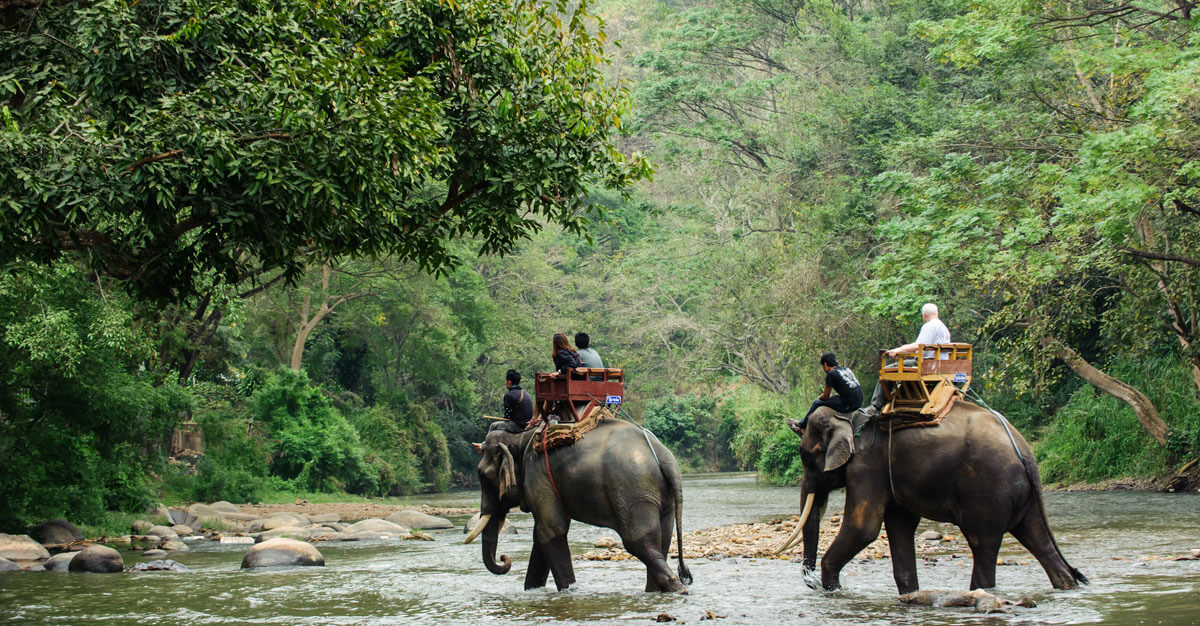
What Vaccines Do I Need for Traveling to Southeast Asia?
Home to Jakarta, Indonesia ; Ho Chi Minh City, Vietnam ; and Bangkok, Thailand , Southeast Asia is a very popular destination for travelers. Prior to the COVID-19 pandemic in 2019, almost 40 million tourists visited Thailand, more than 26 million vacationed in Malaysia , and over 19 million spent time in Singapore .
If you plan to visit Southeast Asia in the coming months, there are some precautions you should take to make sure you stay safe and healthy on your journey. Let’s discuss recommended vaccinations and other tips to help make sure you bring only happy memories back from your trip.
Recommended Vaccinations
In general, the U.S. Centers for Disease Control and Prevention (CDC) recommends the following vaccinations before traveling to Southeast Asian countries such as Malaysia, Thailand, Indonesia, and Vietnam:
- Hepatitis A and B
- Japanese Encephalitis
- Yellow Fever
The CDC also recommends travelers update their routine vaccinations for the following diseases:
- MMR (Measles/Mumps/Rubella)
- Diphtheria-Tetanus-Pertussis
Southeast Asia Traveling Tips
Updating your vaccines is just one way to protect yourself from disease while traveling. Here are some other tips to follow when wandering through the beautiful countries, cities, and towns of Southeast Asia.
Avoid Contaminated Water
Different areas of the world have different standards for their water. Some countries in Southeast Asia are at a higher risk of having contaminated water. This can cause travelers’ diarrhea — a bacterial infection that can be very serious for older adults or people with chronic diseases.
When traveling, a good rule of thumb is to always drink bottled water. And if you must drink tap water, make sure you have a filter to use to help remove any bacteria before drinking.
Watch Out for Bugs
Bugs such as mosquitoes, fleas, and ticks can carry a variety of diseases such as zika , dengue , and chikungunya . As many areas of Southeast Asia have high humidity or are on the coast, these types of bugs can be more prevalent.
Protect yourself from these bugs by wearing long-sleeved clothing whenever possible, as well as a hat to protect your head. Try to sleep only in closed rooms with air conditioning or with a bed net. And use insect repellent if possible to help ward off unwanted insects.
Practice Healthy Habits
Whether it’s on a plane, train, taxi cab, boat, or subway, travelers are always exposed to more germs than anyone really wants to think about. Keep yourself healthy by keeping up with some simple healthy habits:
- Wash your hands all the time, especially before eating.
- Keep hand sanitizer with you in case you do not have access to soap and water.
- Try not to touch your mouth, nose, or eyes.
If you’ll be traveling to Southeast Asia and need to update your vaccinations, call or book online to schedule your appointment today.
Written for Passport Health by Corrie Pelc. Corrie Pelc is a freelance writer in the Dallas-Fort Worth area. She has a passion for health and wellness, having written for publications including Exceptional Parent, DAYSPA, INVISION, Eyecare Professional, and Hepatitis Magazine.
- PIPEDA Policy and Consent Form
- Privacy Policy
- Automatic Data Collection Statement
Vaccines for Traveling to Asia: The Complete Guide
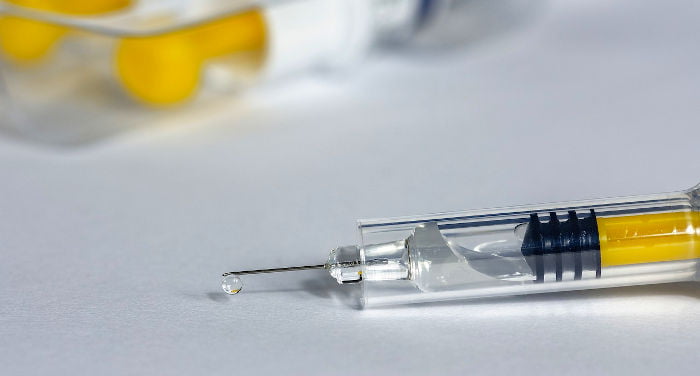
This article gives an informative list of the vaccines necessary for traveling to China, East Asia and Southeast Asia.
Vaccines for Asia – Table of Contents
General situation of vaccines.
- Most common vaccines for traveling to Asia
Other diseases to consider
Coronavirus covid-19, precautions after your trip.
Before anything else, it is essential that you book an appointment with a specialist doctor at an approved international vaccination center or at a travel clinic (many public and private hospitals have one), preferably two months in advance of your departure date.
These are the only types of centers where you will receive up-to-date and detailed advice on all of the vaccines recommended for your trip.
I’m sure you can remember some of the controversies around vaccination that have arisen over the past decades. In the mid-1990s, a renowned British scientist concluded that the measles vaccine could trigger diseases such as autism or colitis.
Despite the fact that he was accused of data falsification and fraud in 2010, he currently has thousands of followers who support him across the globe, through the ever-expanding anti-vaccine movement.
However, official bodies such as the WHO, the pharmaceutical industry, the scientific community, and governments actively support and promote vaccination, in line with the conclusions of the latest science on the subject.
If we cast aside the political and economic interests that can be hidden behind these types of scandals, on the individual level, it is important to consider the risks of not getting vaccinated for potentially lethal diseases before making any decision. You also have to keep in mind that some vaccinations are subject to international regulations , such as the yellow fever vaccine. This means that countries have the power to require visitors to demonstrate that they have been vaccinated in accordance with national regulations if they want to enter the country.
This vaccine is only given at authorized international vaccination centers ( check here for the list of centers in US ), which provide you with an international vaccination certificate (also called a “yellow card”) recognized across the globe.
In any event, you will have to set aside a portion of your budget for vaccines , but keep in mind that the majority of these are for life, and in the worst case, you will have to remember to get a booster shot after a few years.
On the other hand, a distinction must be made between ordinary vaccination (the vaccination normally provided by governments following a specific schedule) and international vaccination (which is done when people go to another country).
Although there are slight variations, the vaccines normally given to the population in the majority of countries are the following: hepatitis B, diphtheria, tetanus, whooping cough, polio, measles, rubella, and chickenpox.
It is very important to possess and periodically go over both vaccination histories (ordinary and international). Keep in mind that a large quantity of money and effort continues to be invested in improving existing vaccines and creating new ones.
Sometimes new evidence is published recommending changes in the period of effectiveness of a vaccine or in the frequency at which booster shots should be given, for example. Because of this, before any international trip, you should consider booking an appointment with a specialist to check that you are up-to-date with all of your vaccines.
Most common international vaccines for traveling to East Asia and Southeast Asia
This table shows the vaccines recommended for traveling to Asia by the Centers for Disease Control and Prevention (CDC), the leading institution in the world in terms of international vaccination.
To summarize, the most commonly recommended vaccines are typhoid fever, tetanus, and hepatitis A and B . The latter is routinely given in many countries, but in any case, carefully go over your medical records and vaccination cards.
If you are not up to date, the best thing to do is to check with your family doctor. It’s possible to find out which vaccines you have through a blood test (which looks for the presence of antibodies).
Returning to the table, whether or not to get optional vaccines will depend on your itinerary, the duration of your trip, the sanitary conditions of your destination country, your age and your state of health , as well as the type of trip you are planning (adventure, business, volunteer work, family, etc.).
Because of this, it’s important to manage your vaccines long enough in advance, because in addition to potential waiting lists at authorized centers, some vaccines take up to three weeks to become effective .
Because of this, as suggested at the beginning of this article, the best thing is to start the procedure two months before your trip .
Yellow fever
This is a notifiable disease according to international regulations and is transmitted via the bite of an infected mosquito. “Notifiable” means that it is necessary to demonstrate that you are vaccinated to enter certain countries.
China and countries in Southeast Asia require travelers coming from countries endemic with yellow fever to present their international vaccination card containing the vaccination against this tropical illness at customs.
Because the vaccine takes ten days to become effective, vaccination is only considered legal once this time period has elapsed. Currently, a single injectable dose gives immunity for your entire life.
This is a disease that affects almost all tropical countries, including those of Southeast Asia and some of the southern provinces of China (but not Hong Kong and Macau). Just like yellow fever, it is transmitted through mosquito bites, but as opposed to yellow fever, there is currently no effective vaccine available for it.
What does exist is a preventive medication that can help mitigate the symptoms of malaria (in the event of infection). However, you should be aware that even by taking this medication, the possibility of developing malaria is not eliminated completely.
Another thing to keep in mind is that the strains of the parasite that cause illness vary from one region to another. Therefore, your route should be as clearly defined as possible in order for you to inform the international vaccination center of it.
This center is the only place where you will get precise recommendations on the prophylactic treatment of choice for the strain that you may encounter along your itinerary.
On the other hand, the majority of urban areas in the region are malaria-free. Therefore, if there isn’t a tangible risk, it’s most likely that your doctor won’t prescribe this treatment for you. The dosage schedule is strict and is followed before, during and after the trip, and the treatment is known for its side effects.
This is a viral infection once again transmitted by mosquito bites. It is also present in the majority of countries in Southeast Asia. It does not have a vaccine, and prevention is exclusively based on protection against mosquito bites .
This virus is fairly similar to the dengue virus. Zika also carries the recommendation that pregnant women abstain from traveling to countries where cases of Zika have been recorded. The transmission of the virus to fetal blood can cause irreversible damage.
Currently, there is no vaccine for the new coronavirus (COVID-19). However, and due to the global impact that this epidemic is having, the epicenter of which is in Wuhan (China), the scientific community is currently searching for an effective vaccine.
In any event, it is not expected to see the light of day for at least a year. Up until then, people are recommended to take extreme measures to avoid contagion , which takes place via inhalation. These measures include avoiding traveling to areas that are active hotbeds of disease transmission.
Currently, countries in Southeast Asia do not have restrictions on travelers related to the coronavirus. In any event, and considering the speed at which the virus is propagating, it is a good idea to confirm the current number of cases in the country that you plan to visit.
Last of all, you should keep in mind that some countries are applying restrictions to travelers coming from China. Therefore, check the order of your itinerary to avoid problems at customs.
Some infectious diseases do not present immediately, and can even show up a long time after you go back home. For any symptoms, it’s best to go to your family doctor and inform them of your itinerary and the dates of all of your trips over the past 12 months.
Photo Credits: Photo by fotoblend on Pixabay
About The Author
Andrea Lasheras
Related posts.


The Stone Forest and the legend of Ashima

From Lijiang to Lugu Lake: Chronicle of a Hectic Trip

Gubeikou: Hiking on the Wild Great Wall
Leave a comment cancel reply.
Your email address will not be published. Required fields are marked *
Save my name, email, and website in this browser for the next time I comment.
Privacy Overview
Get 3 Months FREE with EXPRESS VPN
+ Best VPN For China + 30-Day Money-Back Guarantee + 24/7 Live China Customer Support + 3 Months Free on 12 Months Package
We’re sorry, this site is currently experiencing technical difficulties. Please try again in a few moments. Exception: request blocked
Pregnant Women Advised Not to Travel to 11 Southeast Asian Countries Over Zika Risk
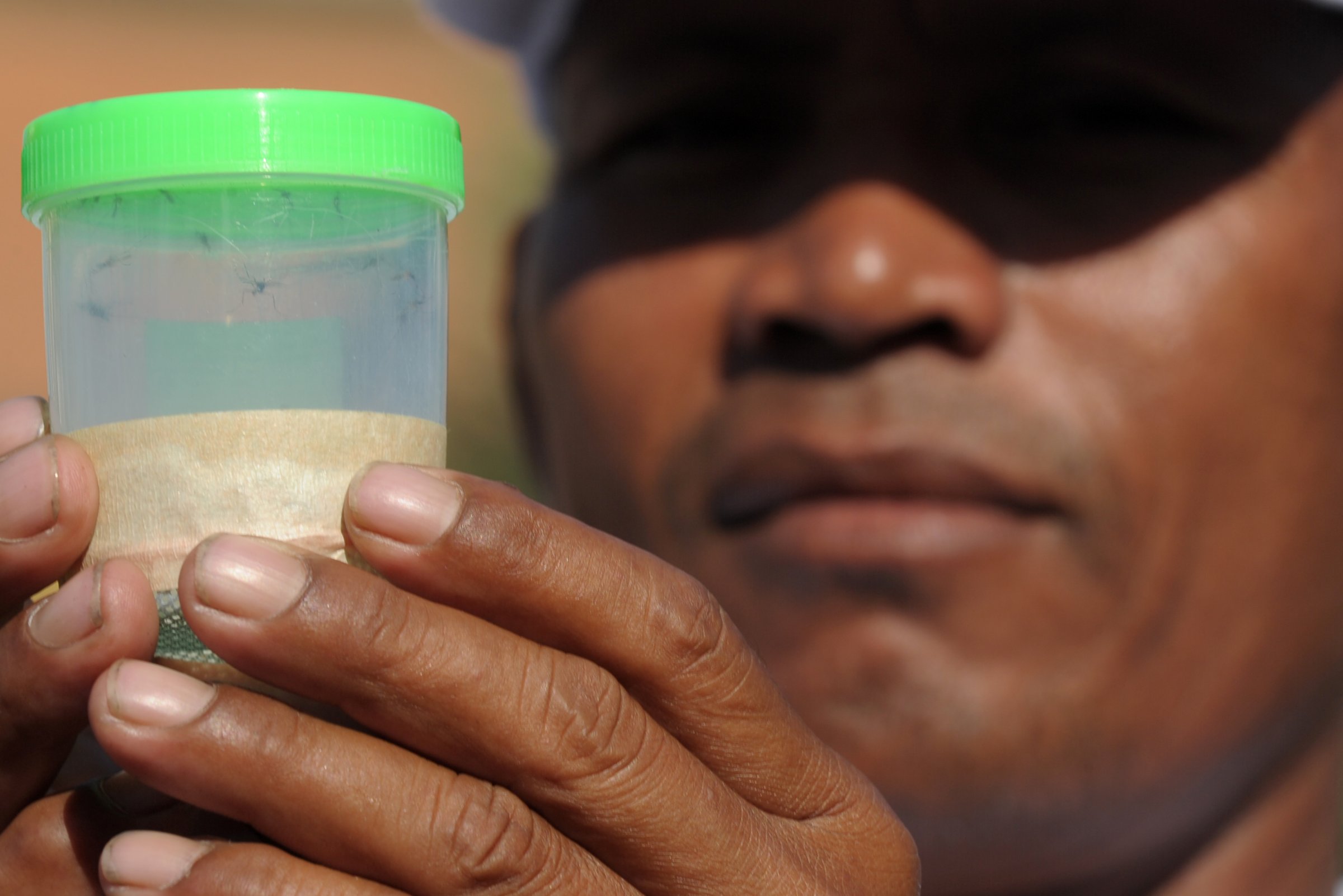
U.S. health officials on Thursday advised pregnant women to avoid nonessential travel to Southeast Asia and the Maldives because of the potential risk of Zika infection, which can cause severe birth defects.
The U.S. Centers for Disease Control (CDC) singled out 11 countries in its latest advisory: Brunei, Burma (Myanmar), Cambodia, Indonesia, Laos, Malaysia, Maldives, Philippines, Thailand, Timor-Leste (East Timor) and Vietnam.
Thursday’s advisory about potential risks in Southeast Asia so far only recommend postponing nonessential travel. The CDC said travelers have been infected with the virus in parts of Southeast Asia, where Zika is endemic and has been present for many years. Many local residents are believed to be immune, though travelers most likely are not.
Read More: Why You Should Care About Zika
“Pregnant women traveling to Southeast Asia could become infected with Zika virus,” the CDC said. “The level of this risk is unknown and likely lower than in areas where Zika virus is newly introduced and spreading widely.”
Zika is a primarily a mosquito-borne disease, but it can also be sexually transmitted. It was identified in Brazil last year and has since spread globally. Infection is not always symptomatic, but can cause a fever similar to dengue. Zika infection during pregnancy can cause serious brain abnormalities such as microcephaly and other birth defects.
Read More: See All the Places Where the Zika Virus Has Spread
The CDC has advised pregnant women to avoid almost 60 countries or regions worldwide because of Zika’s rapid spread.
More Must-Reads From TIME
- Exclusive: Google Workers Revolt Over $1.2 Billion Contract With Israel
- Jane Fonda Champions Climate Action for Every Generation
- Stop Looking for Your Forever Home
- The Sympathizer Counters 50 Years of Hollywood Vietnam War Narratives
- The Bliss of Seeing the Eclipse From Cleveland
- Hormonal Birth Control Doesn’t Deserve Its Bad Reputation
- The Best TV Shows to Watch on Peacock
- Want Weekly Recs on What to Watch, Read, and More? Sign Up for Worth Your Time
Contact us at [email protected]
CDC issues Zika travel advisory for 11 Southeast Asian countries
Reporting by Dipika Jain in Bengaluru, additional reporting by Deena Beasley in Los Angeles and Jeffrey Dastin in New York; Editing by Shounak Dasgupta, Bernard Orr
Our Standards: The Thomson Reuters Trust Principles. , opens new tab

Firm dollar keeps yen pinned near key 152 level
The dollar held near an over four-month peak on Wednesday, pinning the yen close to its lowest its decades though the heightened threat of currency intervention by Tokyo capped further declines in the Japanese currency.


Woman sheds 18 kg via three diet principles

Oversupply, falling China demand halve durian prices

How Truong My Lan’s assets to be used to compensate lender SCB in $27B scam

South Korean singer Park Bo Ram dies at 30

Gold price surges to new historic peak

Singapore Changi world's 5th most luxurious airport

Ho Chi Minh City workers gather under bridges to escape heat

5-day Reunification Day holiday proposal awaits green light

Dollar tiptoes down on black market, remains steady at banks

Who is the youngest billionaire in the world?
Us opens southeast asia cdc office in hanoi.

Speaking at the launching ceremony, visiting U.S. Vice President Kamala Harris noted that the Covid-19 pandemic has taught countries that the world is more interconnected and interdependent than ever before and the threats nations face are accelerating more rapidly.
In this new era, partnership is essential. Countries must be willing to take on the challenges together to create opportunities. Nations know that the Covid-19 pandemic will not be the last threat of its kind that people face, countries should be better prepared for the next one, she said.
In this context, the U.S. wants to help improve public health infrastructure across Southeast Asia, Harris said, adding that her country strongly supports ASEAN's centrality by helping member countries acquire expertise and infrastructure for dealing with Covid-19 and other pandemics in the future.
"That is why the launch of this CDC office and our work together is so very important."
Harris noted that 110 million vaccine doses have shipped out worldwide from the U.S.; and more than 23 million of these have been delivered to Southeast Asia.
The U.S. has also pledged $500,000 for the ASEAN Covid-19 Response Fund to support the purchase of more vaccines. It has provided more than $150 million in emergency assistance for the countries of this region to administer vaccines and to help patients recover, she said.
The U.S wants to work with ASEAN to improve readiness and response in the inevitable event of a future pandemic or another public health crisis. The opening of a regional CDC office is a true testament of the U.S.’s commitment to this region, she said.
Vietnamese Deputy Prime Minister Pham Binh Minh said the launch of the CDC regional office in Hanoi demonstrated the development and vast potential of the comprehensive partnership between Vietnam and the U.S.
It also reflected the high priority that the U.S government places on cooperation with the region in health care and disease control. This is a testament to the ever growing collaboration between the U.S and the region, for mutual interest and for global efforts to protect the health of the people, he said.
"We are also convinced that the office in Hanoi will work closely with partners within and outside the region in pursuit of the crucial goal of ensuring the best healthcare services for the people."
Minh said Southeast Asian countries and the U.S have worked closely together to combat the pandemic, mitigate consequences and foster economic recovery. These endeavors include cooperation to maintain supply chains and mutual assistance in terms of medical equipment and supplies.
He said he hoped that Harris will continue to devote due attention to encouraging U.S. partners to provide vaccines, medications and medical equipment to Southeast Asian countries, including Vietnam in a timely manner "to help countries overcome the pandemic, resume production and business activities and foster economic development...."
National, regional priority
CDC Director Rochelle Walensky re-emphasized VP Harris’s statement that the U.S. and partners share the understanding that health security must be a national security priority. And given that such diseases know no borders, it is also a regional security priority.
"The new office in Hanoi will be essential for global health security and help countries strengthen public health fundamentals throughout the region. It will be the hub for understanding the unique health challenges in Southeast Asia, and in doing so will undoubtedly save many, many lives," Walensky said.
Chair of the ASEAN Health Ministers Meeting, Indonesia's Budi Gunadi Sadikin, said he believed that the U.S.-ASEAN partnership was a stepping stone for countries in the region to build stronger, more responsive and resilient health systems, especially in facing future threats to global health security.
ASEAN looks forward to the U.S. CDC exploring areas of collaborations, the provision of technical assistance, exchanges in supporting the operations of ASEAN Center for Public health emergencies and emerging diseases, he said, adding: "The first priority is achieving ASEAN vaccine security and self-reliance, which is very important right now."
John MacArthur, MD, will be the new CDC Southeast Asia Regional Director. Prior to this appointment, Dr. MacArthur served as the CDC Thailand country director for more than six years. He also served as the CDC’s Team Lead for the U.S. President’s Malaria Initiative, a $620 million per year program to control malaria in sub-Saharan Africa and the Greater Mekong Sub-region.
According to the U.S Embassy in Hanoi, in addition to the Southeast Asia Regional Office, CDC also recently established Regional Offices in Eastern Europe/Central Asia (Georgia), the Middle East/North Africa (Oman), and South America (Brazil).
The embassy said CDC was "uniquely suited to increase American engagement and collaboration with Southeast Asian leaders to enhance regional capacity to prevent, detect, and respond to infectious diseases and other emerging health threats."
It said priorities for the new regional office would include: building tomorrow's public health workforce; expanding regional public health laboratory training; developing innovative programs to improve health for mobile and migrant populations; ensuring a coordinated response to public health emergencies through networked Emergency Operation Centers; and strengthening the early warning system for the detection of zoonotic and emerging infectious diseases.
- Tắt chia sẻ
I've traveled to 9 out of 10 countries in Southeast Asia. Here are the 5 biggest mistakes I made along the way.
- I've traveled solo to nine countries in Southeast Asia.
- I've made many mistakes, from traveling during monsoon season to forgetting to bring enough cash.
- Travelers should make sure they plan ahead and research each country's culture.

Over the last two years, my journey as a travel enthusiast and Business Insider's travel reporter in Singapore has brought me to almost every country in Southeast Asia.
In total, there are 10 countries in Southeast Asia , and I've traveled to nine of them — Singapore, Philippines, Malaysia, Vietnam, Thailand, Indonesia, Cambodia, Laos, and Brunei. Myanmar remains the only country in the region I have not visited, and while I am keen to explore it, I have held off on visiting because of the country's ongoing civil war.
I've watched the sun rise in Angkor Wat in Cambodia and cared for elephants in Chiang Mai, Thailand. I've explored the Bornean jungle in Brunei and crawled the Cu Chi Tunnels in southern Vietnam.
But it hasn't always been easy. I've made several mistakes traveling across the region , especially as a solo traveler. Here are five mistakes I made and how to avoid them.
1. Going during monsoon season and not planning for the weather.
In July, I traveled to Thailand on a reporting trip to cover the budding cannabis industry . There, I was met with heavy rain nearly every day. In Bangkok, I was staying in a hostel in Chakkrawat , a district with narrow, meandering streets, which made it difficult to walk anywhere in the pouring rain.
I didn't plan for the weather, so I didn't have an umbrella or poncho with me and had to rush to get one at the last minute. I also had a packed itinerary with a lot of travel between meetings, which was a hassle in the constant downpour.
Before traveling to Southeast Asia, make sure to avoid two seasons — the monsoon season, which often comes with strong typhoons in countries like the Philippines, and the burning season, where farmers burn land for fertile soil. This is a common occurrence in countries like Laos, Thailand, and the island of Borneo, which is shared between Brunei, Indonesia, and Malaysia.
When I traveled to Laos in April last year during the burning season , most of my plans — including a hot air balloon ride — were canceled because of the thick smog. I also didn't have an N95 mask with me, and I ended up with a sore throat.
If you do plan to come during these seasons, make sure to pack accordingly and plan a flexible schedule.
2. Traveling during Ramadan and expecting the same practices everywhere.
Having grown up in Singapore, I'm familiar with the practices during Ramadan , the holy month for Muslims, where they fast for most of the day. I studied Malay for seven years, and in school, I often fasted with my Muslim classmates and ate only in private.
Still, in many cities in Singapore, Malaysia, and Indonesia , non-Muslims are free to dine in public, so long as they do so respectfully. But on my trip to Brunei in April — at the height of the burning season and in the middle of Ramadan — there were more practices I needed to observe.
Most restaurants were closed, and diners weren't allowed to eat there even if they were open — only take-out was allowed. Eating in public was a major faux pas even for non-Muslims, and if you want to drink some water, you can only do so when nobody is around.
It wasn't easy, especially as Brunei was sweltering at 100 degrees Fahrenheit on some days. I made do by returning to the hotel for lunch and grabbing a big dinner with the locals at the night market after they had broken their fast.
3. Not packing enough modest outfits when visiting temples and mosques.
Southeast Asia is pretty liberal, and you can wear whatever you want in many places. In popular destinations like Phuket, Thailand, and Bali, Indonesia, lots of tourists walk around in bikini tops and shorts, and locals mostly tolerate it.
But there are certain places you do need to cover up, like places of worship, which include temples and mosques. When I visited Angkor Wat — the famed temple complex in Cambodia — in February last year, I found some tourists being told off by the local tour guides for wearing shorts and tank tops — "Tomb Raider" style.
I've learned to err on the right side of caution and bring a sarong wherever I go. It's an easy way to cover up and make an outfit more modest when you need to.
4. Forgetting to pack medication, especially when I plan to eat street food.
Southeast Asia has some of the world's most flavorful food. In every country, you can find food that is cheap and delicious, and that includes Singapore , the world's most expensive city. In countries like Malaysia and Vietnam, street food dishes can cost as little as a dollar.
I eat mostly street food when I travel in Southeast Asia, so medicine for tummy-related illnesses is a must. I've only gotten sick twice from eating street food — and it was the same dish both times— and unfortunately, those were the few times I didn't have medicine with me.
I'm a pretty adventurous eater. I've eaten everything from pufferfish stew to frog porridge and dishes made with intestines off the street. I've learned to wash the utensils provided before digging in and make sure the food is cooked to order and heated up before being served.
5. Relying on my card and not bringing enough cash with me.
In Singapore, I don't really use cash and often use Apple Pay, mobile payments, and cards. But I've found that many stores in other countries in Southeast Asia only accept cash.
For example, on my third trip to Vietnam, I spent an hour trying to make payment via bank transfer after the staff at a luxury perfume shop — which was selling items priced upwards of $200 — informed me at the last minute that they didn't accept card or contactless payment.
I've also found the majority of street vendors in the region only accept mobile payment — which is limited to local banks — or cash. I've learned to change a considerable amount of money before leaving the airport and keep whatever I didn't use for my next trip.
- Main content
CDC: Spike in measles cases poses threat to US elimination status
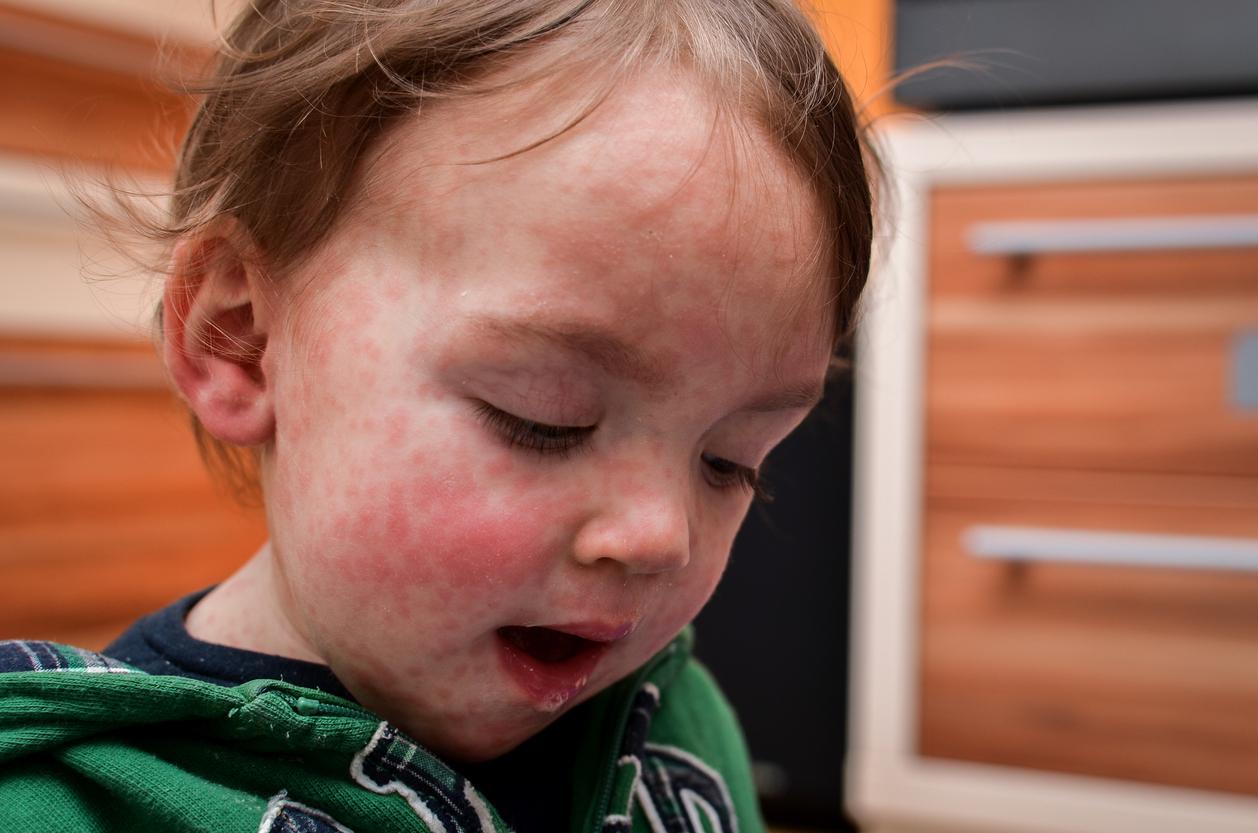
_jure/iStock
A rapid rise in measles cases in the first months of 2024 threatens the United States' elimination status, a situation the nation hasn't faced since 2019, when prolonged outbreaks posed a similar problem, the Centers for Disease Control and Prevention (CDC) said today.
CDC scientists from the group spelled out the warning today in Morbidity and Mortality Weekly Report (MMWR) . In their analysis of measles activity from January 1, 2020, to March 28, 2024, they said cases in the first quarter of 2024 have risen 17-fold compared to the mean first-quarter average from 2020 to 2023.
As of the March 28 data cutoff, 97 cases had been reported to the CDC. In its latest update, which includes infections reported through April 4, the CDC confirmed 113 cases from 18 jurisdictions. Of 20 outbreaks involving 3 or more cases reported since 2020, 7 have occurred in 2024.
Maintaining measles elimination status—which helps reduce cases, deaths, and costs—means that no outbreaks have persisted for 12 months or more in a setting where the surveillance system is working well.
The last threat to US elimination status occurred in 2019, which saw two prolonged outbreaks in undervaccinated communities in New York City and elsewhere in New York state.
More steps needed to maintain elimination
Because of the brisk pace in activity in 2024 so far, more activities are needed to increase measles, mumps, and rubella (MMR) vaccine coverage, especially in close-knit and undervaccinated communities, the CDC said. It said other steps are also needed to maintain measles elimination. "These activities include encouraging vaccination before international travel and rapidly investigating suspected measles cases."
Most cases are still considered imported; however, of those, 61% were in US residents who were eligible for vaccination but were unvaccinated or had an unknown vaccination status.
The CDC is also seeing a shift this year in the overseas regions where people were likely exposed. During the study period, the two most common World Health Organization (WHO) regions were the Eastern Mediterranean (Middle East) and Africa. However, six of the 2024 cases were reported to have originated in the European and Southeast Asia regions—a 50% increase from earlier in the study period.
Along with undervaccination in some of the US population, a global gap in measles vaccination is also fueling the rise in cases, the CDC said. According to global estimates, first-dose coverage declined from 86% in 2019 to 83% in 2022, leaving nearly 22 million children younger than 1 year vulnerable to the virus.
Michigan reports another case as Chicago outbreak grows
In related developments, the Detroit Health Department yesterday reported a measles case involving a 4-year-old child, the fifth case reported in Michigan this year.
The announcement didn't say how the child was exposed. The child's family is following isolation protocols, and no related cases have been reported, so far. The health department warned of potential exposure at three locations where the child was taken for medical care.
Health officials identified the suspected infection on April 3, and tests confirmed the case on April 9.
Elsewhere, the Chicago Department of Public Health reported 3 more cases this week, raising the city's total to 61, most of them linked to an ongoing outbreak at a migrant shelter.
Related news
More measles cases detected in illinois, new york as us total climbs to 64.
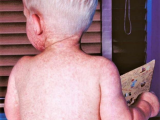
CDC measles alert urges MMR vaccine for youngest international travelers

Chicago measles total rises to 12 cases
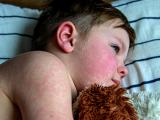
Chicago and Arizona report more measles cases
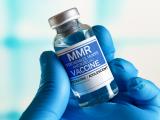
Chicago, California report more measles cases
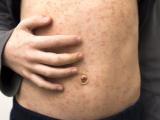
Florida's school measles cluster grows; Ohio and Washington report cases
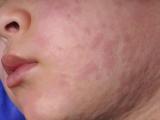
ECDC warns of rising measles cases amid vaccination gaps

Global childhood vaccination rates increase, but not to prepandemic levels
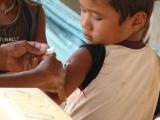
This week's top reads
Cdc sequencing of h5n1 avian flu samples from patient yields new clinical clues.
The nasopharyngeal swab didn't suggest upper respiratory involvement, and virus sequencing of the eye sample showed one change that isn't linked to transmission.
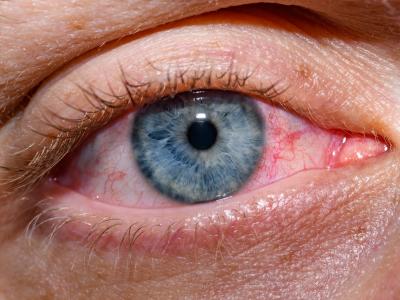
Among fully vaccinated, study shows Paxlovid does not shorten symptoms
The antiviral drug likely has a gradient of benefit, with those at highest risk most likely to see the greatest benefit, experts say in an editorial.
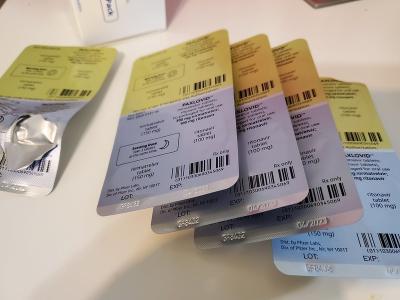
Officials warn of H5N1 avian flu reassortant circulating in parts of Asia
The virus is a reassortant between the older H5N1 clade (2.3.2.1c), still circulating in parts of Asia, and a newer H5N1 clade (2.3.4.4b) that began circulating globally in 2021.
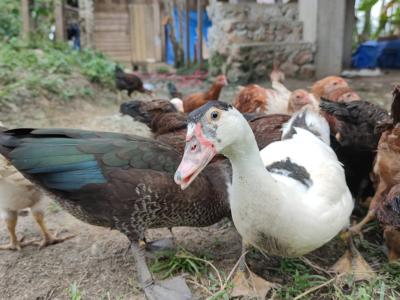
Vietnam reports its first human infection from H9 avian flu virus
The patient lived adjacent to a poultry market, but there were no reports of bird illnesses or deaths.
Wastewater testing near homeless camps shows COVID-19 viral mutations
Analysis of viral sequences uncovered 3 novel viral spike protein mutations.
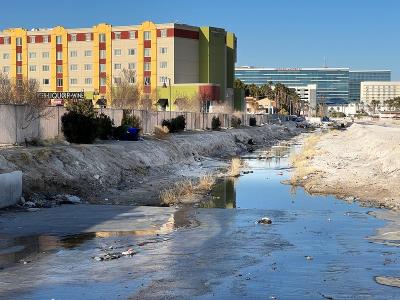
Avian flu detected in North Carolina dairy herd
Seven states have now reported the virus in dairy herds, with detections at 21 facilities.

Blood donor study finds 21% incidence of long-term symptoms attributed to COVID-19
Among blood donors with prior SARS-CoV-2 infection, 23.6% reported long-term neurologic symptoms.
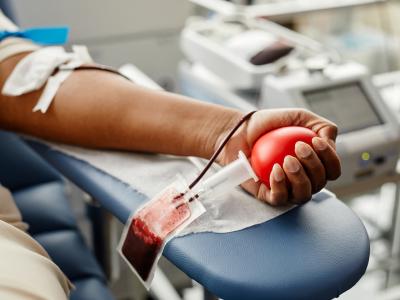
Study links air quality improvements to fewer school COVID cases
The study took place at a school that serves vulnerable students in a setting where air quality improvements were made and then monitored.

No need to avoid exercise with long-COVID diagnosis, researchers say
Participants with long COVID had a 21% lower peak volume of oxygen consumption at baseline.

Study identifies inflammation and symptom patterns in long COVID
Inflammation of myeloid cells and activation of immune proteins that are part of the complement system stood out blood from long COVID patients, but it's not clear if that applies to all types of long COVID.

Our underwriters
Unrestricted financial support provided by.

- Antimicrobial Resistance
- Chronic Wasting Disease
- All Topics A-Z
- Resilient Drug Supply
- Influenza Vaccines Roadmap
- CIDRAP Leadership Forum
- Roadmap Development
- Coronavirus Vaccines Roadmap
- Antimicrobial Stewardship
- Osterholm Update
- Newsletters
- About CIDRAP
- CIDRAP in the News
- Our Director
- Osterholm in the Press
- Shop Merchandise
Measles — United States, January 1, 2020–March 28, 2024
Weekly / April 11, 2024 / 73(14);295–300
Adria D. Mathis, MSPH 1 ; Kelley Raines, MPH 1 ; Nina B. Masters, PhD 1 ; Thomas D. Filardo, MD 1 ; Gimin Kim, MS 1 ; Stephen N. Crooke, PhD 1 ; Bettina Bankamp, PhD 1 ; Paul A. Rota, PhD 1 ; David E. Sugerman, MD 1 ( View author affiliations )
What is already known about this topic?
Although endemic U.S. measles was declared eliminated in 2000, measles importations continue to occur. Prolonged outbreaks during 2019 threatened the U.S. measles elimination status.
What is added by this report?
During January 1, 2020–March 28, 2024, a total of 338 U.S. measles cases were reported; 29% of these cases occurred during the first quarter of 2024, almost all in persons who were unvaccinated or whose vaccination status was unknown. As of the end of 2023, U.S. measles elimination status was maintained.
What are the implications for public health practice?
Risk for widespread U.S. measles transmission remains low because of high population immunity. Enhanced efforts are needed to increase routine U.S. vaccination coverage, encourage vaccination before international travel, identify communities at risk for measles transmission, and rapidly investigate suspected measles cases to reduce cases and complications of measles.
- Article PDF
- Full Issue PDF
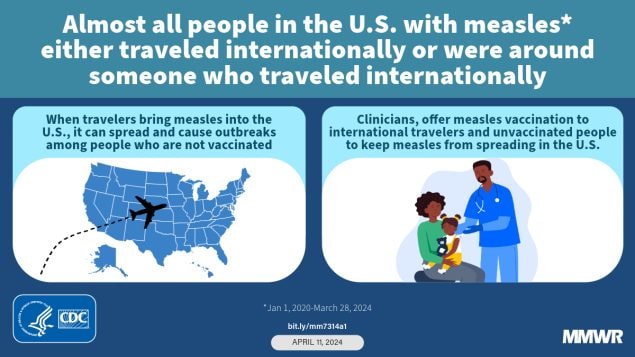
Measles is a highly infectious febrile rash illness and was declared eliminated in the United States in 2000. However, measles importations continue to occur, and U.S. measles elimination status was threatened in 2019 as the result of two prolonged outbreaks among undervaccinated communities in New York and New York City. To assess U.S. measles elimination status after the 2019 outbreaks and to provide context to understand more recent increases in measles cases, CDC analyzed epidemiologic and laboratory surveillance data and the performance of the U.S. measles surveillance system after these outbreaks. During January 1, 2020–March 28, 2024, CDC was notified of 338 confirmed measles cases; 97 (29%) of these cases occurred during the first quarter of 2024, representing a more than seventeenfold increase over the mean number of cases reported during the first quarter of 2020–2023. Among the 338 reported cases, the median patient age was 3 years (range = 0–64 years); 309 (91%) patients were unvaccinated or had unknown vaccination status, and 336 case investigations included information on ≥80% of critical surveillance indicators. During 2020–2023, the longest transmission chain lasted 63 days. As of the end of 2023, because of the absence of sustained measles virus transmission for 12 consecutive months in the presence of a well-performing surveillance system, U.S. measles elimination status was maintained. Risk for widespread U.S. measles transmission remains low because of high population immunity. However, because of the increase in cases during the first quarter of 2024, additional activities are needed to increase U.S. routine measles, mumps, and rubella vaccination coverage, especially among close-knit and undervaccinated communities. These activities include encouraging vaccination before international travel and rapidly investigating suspected measles cases.
Introduction
Measles is a highly infectious acute, febrile rash illness with a >90% secondary attack rate among susceptible contacts ( 1 ). High national 2-dose coverage with the measles, mumps, and rubella (MMR) vaccine led to the declaration of U.S. measles elimination* in 2000 ( 2 ). However, this elimination status was threatened in 2019 because of two prolonged outbreaks among undervaccinated communities in New York and New York City; these outbreaks accounted for 29% of all reported cases during 2001–2019 ( 2 ). To assess U.S. measles elimination status after the 2019 outbreaks and to provide context for understanding more recent increases in measles cases in 2024, † CDC assessed the epidemiologic and laboratory-based surveillance of measles in the United States and the performance of the U.S. measles surveillance system during January 1, 2020–March 28, 2024.
Reporting and Classification of Measles Cases
Confirmed measles cases § ( 1 ) are reported to CDC by state health departments through the National Notifiable Disease Surveillance System and directly (by email or telephone) to the National Center for Immunization and Respiratory Diseases. Measles cases are classified by the Council of State and Territorial Epidemiologists as import-associated if they were internationally imported, epidemiologically linked to an imported case, or had viral genetic evidence of an imported measles genotype ( 1 ); cases with no epidemiologic or virologic link to an imported case are classified as having an unknown source ( 1 ). For this analysis, unique sequences were defined as those differing by at least one nucleotide in the N-450 sequence (the 450 nucleotides encoding the carboxyl-terminal 150 nucleoprotein amino acids) based on the standard World Health Organization (WHO) recommendations for describing sequence variants ¶ ( 3 ). Unvaccinated patients were classified as eligible for vaccination if they were not vaccinated according to Advisory Committee on Immunization Practices recommendations ( 4 ). A well-performing surveillance system was defined as one with ≥80% of cases meeting each of the following three criteria: classified as import-associated, reported with complete information on at least eight of 10 critical surveillance indicators (i.e., place of residence, sex, age, occurrence of fever and rash, date of rash onset, vaccination status, travel history, hospitalization, transmission setting, and whether the case was outbreak-related) ( 5 ), and laboratory-confirmed.
Assessment of Chains of Transmission
Cases were classified into chains of transmission on the basis of known epidemiologic linkages: isolated (single) cases, two-case chains (two epidemiologically linked cases), and outbreaks (three or more epidemiologically linked cases). The potential for missed cases within two-case chains and outbreaks was assessed by measuring the interval between measles rash onset dates in each chain; chains with more than one maximum incubation period (21 days) between cases could indicate a missing case in the chain. This activity was reviewed by CDC, deemed not research, and was conducted consistent with applicable federal law and CDC policy.**
Reported Measles Cases and Outbreaks
CDC was notified of 338 confirmed measles cases with rash onset during January 1, 2020–March 28, 2024 ( Figure ); cases occurred in 30 jurisdictions. During 2020, 12 of 13 cases preceded the commencement of COVID-19 mitigation efforts in March 2020. Among the 170 cases reported during 2021 and 2022, 133 (78%) were associated with distinct outbreaks: 47 (96%) of 49 cases in 2021 occurred among Afghan evacuees temporarily housed at U.S. military bases during Operation Allies Welcome, and 86 (71%) of 121 cases in 2022 were associated with an outbreak in central Ohio. During 2023, 28 (48%) of 58 cases were associated with four outbreaks. As of March 28, 2024, a total of 97 cases have been reported in 2024, representing 29% of all 338 measles cases reported during January 1, 2020–March 28, 2024, and more than a seventeenfold increase over the mean number of cases reported during the first quarter of 2020–2023 (five cases).
Characteristics of Reported Measles Cases
The median patient age was 3 years (range = 0–64 years); more than one half of cases (191; 58%) occurred in persons aged 16 months–19 years ( Table ). Overall, 309 (91%) patients were unvaccinated (68%) or had unknown vaccination status (23%); 29 (9%) had previously received ≥1 MMR vaccine dose. Among the 309 cases among unvaccinated persons or persons with unknown vaccination status, 259 (84%) patients were eligible for vaccination, 40 (13%) were aged 6–11 months and therefore not recommended for routine MMR vaccination, and 10 (3%) were ineligible for MMR because they were aged <6 months. †† Among 155 (46%) hospitalized measles patients, 109 (70%) cases occurred in persons aged <5 years; 142 (92%) hospitalized patients were unvaccinated or had unknown vaccination status. No measles-associated deaths were reported to CDC.
Imported Measles Cases
Among all 338 cases, 326 (96%) were associated with an importation; 12 (4%) had an unknown source. Among the 326 import-associated cases, 200 (61%) occurred among U.S. residents who were eligible for vaccination but who were unvaccinated or whose vaccination status was unknown. Among 93 (28%) measles cases that were directly imported from other countries, 34 (37%) occurred in foreign visitors, and 59 (63%) occurred in U.S. residents, 53 (90%) of whom were eligible for vaccination but were unvaccinated or whose vaccination status was unknown. One (2%) case in a U.S. resident occurred in a person too young for vaccination, two (3%) in persons who had previously received 1 MMR vaccine dose, and three (5%) in persons who had previously received 2 MMR vaccine doses. The most common source for internationally imported cases during the study period were the Eastern Mediterranean (48) and African (24) WHO regions. During the first quarter of 2024, a total of six internationally imported cases were reported from the European and South-East Asia WHO regions, representing a 50% increase over the mean number of importations from these regions during 2020–2023 (mean of two importations per year from each region).
Surveillance Quality Indicators
Overall, all but two of the 338 case investigations included information on ≥80% of the critical surveillance indicators; those two case investigations included information on 70% of critical surveillance indicators. Date of first case report to a health department was available for 219 (65%) case investigations; 127 (58%) cases were reported to health departments on or before the day of rash onset (IQR = 4 days before to 3 days after). Overall, 314 (93%) measles cases were laboratory confirmed, including 16 (5%) by immunoglobulin M (serologic) testing alone and 298 (95%) by real-time reverse transcription–polymerase chain reaction (rRT-PCR). Among 298 rRT-PCR–positive specimens, 221 (74%) were successfully genotyped: 177 (80%) were genotype B3, and 44 (20%) were genotype D8. Twenty-two distinct sequence identifiers (DSIds) ( 3 ) for genotype B3 and 13 DSIds for genotype D8 were detected (Supplementary Figure, https://stacks.cdc.gov/view/cdc/152776 ). The longest period of detection for any DSId was 15 weeks (DSId 8346).
Chains of Transmission
The 338 measles cases were categorized into 92 transmission chains (Table); 62 (67%) were isolated cases, 10 (11%) were two-case chains, and 20 (22%) were outbreaks of three or more cases. Seven (35%) of 20 outbreaks occurred during 2024. §§ The median outbreak size was six cases (range = three–86 cases) and median duration of transmission was 20 days (range = 6–63 days). Among the 30 two-case chains and outbreaks, more than one maximum incubation period (21 days) did not elapse between any two cases.
Because of the absence of endemic measles virus transmission for 12 consecutive months in the presence of a well-performing surveillance system, as of the end of 2023, measles elimination has been maintained in the United States. U.S. measles elimination reduces the number of cases, deaths, and costs that would occur if endemic measles transmission were reestablished. Investigation of almost all U.S. measles cases reported since January 2020 were import-associated, included complete information on critical surveillance variables, were laboratory-confirmed by rRT-PCR, and underwent genotyping; these findings indicate that the U.S. measles surveillance system is performing well. A variety of transmission chain sizes were detected, including isolated cases, suggesting that sustained measles transmission would be rapidly detected. However, the rapid increase in the number of reported measles cases during the first quarter of 2024 represents a renewed threat to elimination.
Most measles importations were cases among persons traveling to and from countries in the Eastern Mediterranean and African WHO regions; these regions experienced the highest reported measles incidence among all WHO regions during 2021–2022 ( 6 ). During November 2022–October 2023, the number of countries reporting large or disruptive outbreaks increased by 123%, from 22 to 49. Global estimates suggest that first-dose measles vaccination coverage had declined from 86% in 2019 to 83% in 2022, leaving almost 22 million children aged <1 year susceptible to measles ( 6 ).
As has been the case in previous postelimination years ( 7 ), most imported measles cases occurred among unvaccinated U.S. residents. Increasing global measles incidence and decreasing vaccination coverage will increase the risk for importations into U.S. communities, as has been observed during the first quarter of 2024, further supporting CDC’s recommendation for persons to receive MMR vaccine before international travel ( 4 ).
Maintaining high national and local MMR vaccination coverage remains central to sustaining measles elimination. Risk for widespread U.S. measles transmission remains low because of high population immunity; however, national 2-dose MMR vaccination coverage has remained below the Healthy People 2030 target of 95% (the estimated population-level immunity necessary to prevent sustained measles transmission) ( 8 ) for 3 consecutive years, leaving approximately 250,000 kindergarten children susceptible to measles each year ( 9 ). Furthermore, 2-dose MMR vaccination coverage estimates in 12 states and the District of Columbia were <90%, and during the 2022–23 school year, exemption rates among kindergarten children exceeded 5% in 10 states ( 9 ). Clusters of unvaccinated persons placed communities at risk for large outbreaks, as occurred during the central Ohio outbreak in 2022: 94% of measles patients were unvaccinated and 42% were hospitalized ( 10 ). Monitoring MMR vaccination coverage at county and zip code levels could help public health agencies identify undervaccinated communities for targeted interventions to improve vaccination coverage while preparing for possible measles outbreaks. As of March 28, 2024, a total of 97 confirmed measles cases have been reported in the United States in 2024, compared with a mean of five cases during the first quarter of each year during 2020–2023. Similar to cases reported during 2020–2023, most cases reported during 2024 occurred among patients aged <20 years who were unvaccinated or whose vaccination status was unknown, and were associated with an importation. Rapid detection of cases, prompt implementation of control measures, and maintenance of high national measles vaccination coverage, including improving coverage in undervaccinated populations, is essential to preventing measles and its complications and to maintaining U.S. elimination status.
Limitations
The findings in this report are subject to at least three limitations. First, importations might have been underreported: 4% of reported cases during the study period had no known source. Second, case investigations resulting in discarded measles cases (i.e., a diagnosis of measles excluded) are not nationally reportable, which limits the ability to directly evaluate the sensitivity of measles case investigations. However, surveillance remains sufficiently sensitive to detect isolated cases and outbreaks, and robust molecular epidemiology provides further evidence supporting the absence of sustained measles transmission in the United States. Finally, the date of first case report to a health department was not available for 35% of case investigations.
Implications for Public Health Practice
The U.S. measles elimination status will continue to be threatened by global increases in measles incidence and decreases in global, national, and local measles vaccination coverage. Because of high population immunity, the risk of widespread measles transmission in the United States remains low; however, efforts are needed to increase routine MMR vaccination coverage, encourage vaccination before international travel, identify communities at risk for measles transmission, and rapidly investigate suspected measles cases to maintain elimination.
Corresponding author: Adria D. Mathis, [email protected] .
1 Division of Viral Diseases, National Center for Immunization and Respiratory Diseases, CDC.
All authors have completed and submitted the International Committee of Medical Journal Editors form for disclosure of potential conflicts of interest. Stephen N. Crooke reports institutional support from PATH. No other potential conflicts of interest were disclosed.
* Elimination is defined as the absence of endemic measles virus transmission in a defined geographic area for ≥12 months in the presence of a well-performing surveillance system.
† https://emergency.cdc.gov/han/2024/han00504.asp
§ A confirmed measles case was defined as an acute febrile rash illness with laboratory confirmation or direct epidemiologic linkage to a laboratory-confirmed case. Laboratory confirmation was defined as detection of measles virus–specific nucleic acid from a clinical specimen using real-time reverse transcription–polymerase chain reaction or a positive serologic test for measles immunoglobulin M antibody.
¶ Genotyping was performed at CDC and at the Vaccine Preventable Disease Reference Centers of the Association of Public Health Laboratories.
** 45 C.F.R. part 46.102(l)(2), 21 C.F.R. part 56; 42 U.S.C. Sect. 241(d); 5 U.S.C. Sect. 552a; 44 U.S.C. Sect. 3501 et seq.
†† MMR vaccine is not licensed for use in persons aged <6 months.
§§ At the time of this report, six measles outbreaks have ended, and one outbreak is ongoing. A measles outbreak is considered to be over when no new cases have been identified during two incubation periods (42 days) since the rash onset in the last outbreak-related case.
- Gastañaduy PA, Redd SB, Clemmons NS, et al. Measles [Chapter 7]. In: Manual for the surveillance of vaccine-preventable diseases. Atlanta, GA: US Department of Health and Human Services, CDC; 2023. https://www.cdc.gov/vaccines/pubs/surv-manual/chpt07-measles.html
- Mathis AD, Clemmons NS, Redd SB, et al. Maintenance of measles elimination status in the United States for 20 years despite increasing challenges. Clin Infect Dis 2022;75:416–24. https://doi.org/10.1093/cid/ciab979 PMID:34849648
- Williams D, Penedos A, Bankamp B, et al. Update: circulation of active genotypes of measles virus and recommendations for use of sequence analysis to monitor viral transmission. Weekly Epidemiologic Record 2022;97(39):481–92. https://reliefweb.int/report/world/weekly-epidemiological-record-wer-30-september-2022-vol-97-no-39-2022-pp-481-492-enfr
- McLean HQ, Fiebelkorn AP, Temte JL, Wallace GS; CDC. Prevention of measles, rubella, congenital rubella syndrome, and mumps, 2013: summary recommendations of the Advisory Committee on Immunization Practices (ACIP). MMWR Recomm Rep 2013;62(No. RR-4):1–34. PMID:23760231
- World Health Organization. Measles: vaccine preventable diseases surveillance standards. Geneva, Switzerland: World Health Organization; 2018. https://www.who.int/publications/m/item/vaccine-preventable-diseases-surveillance-standards-measles
- Minta AA, Ferrari M, Antoni S, et al. Progress toward measles elimination—worldwide, 2000–2022. MMWR Morb Mortal Wkly Rep 2023;72:1262–8. https://doi.org/10.15585/mmwr.mm7246a3 PMID:37971951
- Lee AD, Clemmons NS, Patel M, Gastañaduy PA. International importations of measles virus into the United States during the postelimination era, 2001–2016. J Infect Dis 2019;219:1616–23. https://doi.org/10.1093/infdis/jiy701 PMID:30535027
- Truelove SA, Graham M, Moss WJ, Metcalf CJE, Ferrari MJ, Lessler J. Characterizing the impact of spatial clustering of susceptibility for measles elimination. Vaccine 2019;37:732–41. https://doi.org/10.1016/j.vaccine.2018.12.012 PMID:30579756
- Seither R, Yusuf OB, Dramann D, Calhoun K, Mugerwa-Kasujja A, Knighton CL. Coverage with selected vaccines and exemption from school vaccine requirements among children in kindergarten—United States, 2022–23 school year. MMWR Morb Mortal Wkly Rep 2023;72:1217–24. https://doi.org/10.15585/mmwr.mm7245a2 PMID:37943705
- Tiller EC, Masters NB, Raines KL, et al. Notes from the field: measles outbreak—central Ohio, 2022–2023. MMWR Morb Mortal Wkly Rep 2023;72:847–9. https://doi.org/10.15585/mmwr.mm7231a3 PMID:37535476
FIGURE . Confirmed measles cases, by month of rash onset (N = 338) — United States, January 1, 2020–March 28, 2024
Abbreviations: IgM = immunoglobulin M; rRT-PCR = real-time reverse transcription–polymerase chain reaction; WHO = World Health Organization. * A case resulting from exposure to measles virus outside the United States as evidenced by at least some of the exposure period (7–21 days before rash onset) occurring outside the United States and rash onset occurring within 21 days of entering the United States without known exposure to measles during that time. † A case in a transmission chain epidemiologically linked to an internationally imported case. § A case for which an epidemiologic link to an internationally imported case was not identified, but for which viral sequence data indicate an imported measles genotype (i.e., a genotype that is not detected in the United States with a pattern indicative of endemic transmission). ¶ A case for which an epidemiologic or virologic link to importation or to endemic transmission within the United States cannot be established after a thorough investigation. ** Percentage is percentage of international importations. Four cases among persons who traveled to both the Eastern Mediterranean and African regions and one case in a person who traveled to both the Eastern Mediterranean and European regions were counted twice. †† Place of residence, sex, age or date of birth, fever and rash, date of rash onset, vaccination status, travel history, hospitalization, transmission setting, and whether the case was outbreak related. §§ Includes 65 cases among patients who received both positive rRT-PCR and positive IgM results. ¶¶ Percentage is percentage of total chains.
Suggested citation for this article: Mathis AD, Raines K, Masters NB, et al. Measles — United States, January 1, 2020–March 28, 2024. MMWR Morb Mortal Wkly Rep 2024;73:295–300. DOI: http://dx.doi.org/10.15585/mmwr.mm7314a1 .
MMWR and Morbidity and Mortality Weekly Report are service marks of the U.S. Department of Health and Human Services. Use of trade names and commercial sources is for identification only and does not imply endorsement by the U.S. Department of Health and Human Services. References to non-CDC sites on the Internet are provided as a service to MMWR readers and do not constitute or imply endorsement of these organizations or their programs by CDC or the U.S. Department of Health and Human Services. CDC is not responsible for the content of pages found at these sites. URL addresses listed in MMWR were current as of the date of publication.
All HTML versions of MMWR articles are generated from final proofs through an automated process. This conversion might result in character translation or format errors in the HTML version. Users are referred to the electronic PDF version ( https://www.cdc.gov/mmwr ) and/or the original MMWR paper copy for printable versions of official text, figures, and tables.
Exit Notification / Disclaimer Policy
- The Centers for Disease Control and Prevention (CDC) cannot attest to the accuracy of a non-federal website.
- Linking to a non-federal website does not constitute an endorsement by CDC or any of its employees of the sponsors or the information and products presented on the website.
- You will be subject to the destination website's privacy policy when you follow the link.
- CDC is not responsible for Section 508 compliance (accessibility) on other federal or private website.
- Work & Careers
- Life & Arts
Become an FT subscriber
Try unlimited access Only $1 for 4 weeks
Then $75 per month. Complete digital access to quality FT journalism on any device. Cancel anytime during your trial.
- Global news & analysis
- Expert opinion
- Special features
- FirstFT newsletter
- Videos & Podcasts
- Android & iOS app
- FT Edit app
- 10 gift articles per month
Explore more offers.
Standard digital.
- FT Digital Edition
Premium Digital
Print + premium digital, digital standard + weekend, digital premium + weekend.
Today's FT newspaper for easy reading on any device. This does not include ft.com or FT App access.
- 10 additional gift articles per month
- Global news & analysis
- Exclusive FT analysis
- Videos & Podcasts
- FT App on Android & iOS
- Everything in Standard Digital
- Premium newsletters
- Weekday Print Edition
- FT Weekend newspaper delivered Saturday plus standard digital access
- FT Weekend Print edition
- FT Weekend Digital edition
- FT Weekend newspaper delivered Saturday plus complete digital access
- Everything in Preimum Digital
Essential digital access to quality FT journalism on any device. Pay a year upfront and save 20%.
- Everything in Print
- Everything in Premium Digital
Complete digital access to quality FT journalism with expert analysis from industry leaders. Pay a year upfront and save 20%.
Terms & Conditions apply
Explore our full range of subscriptions.
Why the ft.
See why over a million readers pay to read the Financial Times.
International Edition

IMAGES
COMMENTS
More. Learn about CDC's Traveler Genomic Surveillance Program that detects new COVID-19 variants entering the country. Sign up to get travel notices, clinical updates, & healthy travel tips. CDC Travelers' Health Branch provides updated travel information, notices, and vaccine requirements to inform international travelers and provide ...
All international travelers should be fully vaccinated against measles with the measles-mumps-rubella (MMR) vaccine, including an early dose for infants 6-11 months, according to CDC's measles vaccination recommendations for international travel. Measles (Rubeola) - CDC Yellow Book. Rabies: Rabid dogs are commonly found in Thailand.
Prevention modalities: vaccination, medication, consultation. Hepatitis A. Contaminated food & water. Vaccination (2-dose vaccine): Recommended for most travelers. --Administer 2 doses, at least 6 months apart. --At least 1 dose should be given before travel. Consultation: Advise patient to wash hands frequently and avoid unsafe food and water.
If you decide to travel, prevent mosquito bites and sexual exposure to Zika during and after travel. If traveling without male partner, wait 2 months after return before becoming pregnant. Men with a pregnant partner. Prevent mosquito bites during and after travel. Use condoms or do not have sex for the rest of the pregnancy.
We would like to show you a description here but the site won't allow us.
Vietnam has a population of approximately 103 million people, with about two-thirds living in rural areas. The total size of Vietnam is 127,243 mi2 (331,114 km2), slightly larger than New Mexico. Located in Southeast Asia, Vietnam shares international borders with China, Laos, and Cambodia. Vietnam is divided into 63 provinces.
CDC's global migration and quarantine experts address public health threats before they cross international borders and prevent the spread of disease among international travelers, immigrants, refugees, and other mobile populations in Southeast Asia. CDC provides technical support to the Thai MOPH and the Lao MOH related to COVID-19 testing ...
In 2020, an estimated 12% of men who have sex with men, and 3% of sex workers (≈4% of male sex workers and 1.7% of female sex workers) in Thailand were living with HIV. Travelers should be aware of the risks of acquiring HIV and other STIs in Thailand, always use condoms during sex, and avoid injecting drugs or sharing needles.
The Southeast Asia region is home to more than 657 million people and consists of various CDC assets including the CDC regional office in Hanoi, Vietnam, and seven bilateral CDC country offices.. CDC investments in the region began with malaria technical assistance in the early 1950s. It continued with successful smallpox eradication efforts and led to the development of country offices ...
Thailand - Level 1: Exercise Normal Precautions. Reissued with obsolete COVID-19 page links removed. Exercise normal precautions in Thailand. Some areas have increased risk. Read the entire Travel Advisory. Reconsider travel to: Yala, Pattani, Narathiwat, and Songkhla provinces due to civil unrest associated with ongoing insurgent activities.
Gamma (P.1) was first identified in travelers from Brazil to Japan, and Delta (B.1.617.2) ... Association of Southeast Asian Nations CDC Center of Disease Control and Prevention COVAX ... [33] Islam OK, et al. Emergence of European and North American mutant variants of SARS-CoV-2 in South-East Asia. Transbound Emerg Dis. 2021; 68 (2):824-832.
Ceftriaxone or fluoroquinolone if low risk of fluoroquinolone resistance (travelers outside of South/Southeast Asia where resistance is >80%) Ceftriaxone for travelers from South/Southeast Asia; Oral antibiotics for uncomplicated disease Fluoroquinolone; Azithromycin; See Traveler's Health Typhoid & Paratyphoid Fever
- Malaria map - Asia and Oceania - Dengue map - Asia and Oceania; RELATED TOPICS. Patient education: General travel advice (Beyond the Basics) Acute and early HIV infection: Clinical manifestations and diagnosis; Acute mountain sickness and high-altitude cerebral edema; Approach to illness associated with travel to East Asia
Recommended Vaccinations. In general, the U.S. Centers for Disease Control and Prevention (CDC) recommends the following vaccinations before traveling to Southeast Asian countries such as Malaysia, Thailand, Indonesia, and Vietnam: COVID-19. Hepatitis A and B. Japanese Encephalitis. Cholera. Malaria. Measles. Typhoid.
This table shows the vaccines recommended for traveling to Asia by the Centers for Disease Control and Prevention (CDC), the leading institution in the world in terms of international vaccination. To summarize, the most commonly recommended vaccines are typhoid fever, tetanus, and hepatitis A and B.
Through TA and cooperative agreements with the World Health Organization (WHO), CDC's Asia Regional Office (ARO) helps to build host-country capacity for sustainable, country-owned programs with targeted assistance in surveillance, laboratory capacity, HIV counseling and testing, adult and pediatric HIV care and treatment quality improvement ...
DGMH-Asia works with partners in Southeast Asia to improve the health of U.S.-bound refugees and immigrants and prevent the spread of infectious diseases through: DGMH-Asia supported and funded a World Health Organization (WHO) course on Ship Sanitation Inspection and Issuance of Ship Sanitation Certificates in Thailand, which included a 2-day ...
HANOI, August 25, 2021 - Vice President Kamala D. Harris today launched the U.S. Centers for Disease Control and Prevention Southeast Asia Regional Office in Hanoi, Vietnam, at a ceremony that included the U.S. Secretary of Health and Human Services, U.S. CDC Director, and a Deputy Prime Minister and Health Ministers from eleven countries.The new Regional Office strengthens CDC's ability ...
Malaria Species 3. Recommended Chemoprophylaxis 4. Key Information Needed and Helpful Links to Assess Need for Prophylaxis for Select Countries. Afghanistan. April-December in all areas at altitudes below 2,500 m (8,202 ft). Chloroquine. Primarily P. vivax . Less commonly, P. falciparum. Atovaquone-proguanil, doxycycline, mefloquine, or ...
September 30, 2016 1:18 AM EDT. U.S. health officials on Thursday advised pregnant women to avoid nonessential travel to Southeast Asia and the Maldives because of the potential risk of Zika ...
4 Min Read. (Reuters) - U.S. health officials on Thursday recommended that pregnant women postpone nonessential travel to 11 Southeast Asian countries because of the risk of Zika virus infection ...
The U.S. Center for Disease Control and Prevention (CDC) launched its Southeast Asia Regional Office in Hanoi Wednesday to facilitate pandemic responses in an interconnected world. Speaking at the launching ceremony, visiting U.S. Vice President Kamala Harris noted that the Covid-19 pandemic has taught countries that the world is more ...
Over the last two years, my journey as a travel enthusiast and Business Insider's travel reporter in Singapore has brought me to almost every country in Southeast Asia.. In total, there are 10 ...
However, six of the 2024 cases were reported to have originated in the European and Southeast Asia regions—a 50% increase from earlier in the study period. Along with undervaccination in some of the US population, a global gap in measles vaccination is also fueling the rise in cases, the CDC said.
Methods Reporting and Classification of Measles Cases. Confirmed measles cases § (1) are reported to CDC by state health departments through the National Notifiable Disease Surveillance System and directly (by email or telephone) to the National Center for Immunization and Respiratory Diseases.Measles cases are classified by the Council of State and Territorial Epidemiologists as import ...
Global coffee prices are soaring as hot, dry weather in major producing countries in south-east Asia spurs fears of shortages. Both cheaper robusta and higher-end arabica beans have rallied ...
The specimens were then sent to the United States Centers for Disease Control and Prevention (US CDC) for further testing. They were received and tested at the US CDC on 30 March and confirmed as high pathogenicity avian influenza (HPAI) A(H5N1) virus clade 2.3.4.4b by RT-PCR and sequencing (1) (2). Genome sequencing of the virus didn't show ...
Some 326 (96%) of the 338 cases were reportedly associated with an importation of the disease due to international travel to and/or from Eastern Mediterranean and African countries. The number of imported cases originating in Europe and South-East Asia jumped from a mean of two per year from each region to six between January and March 2024 ...